Photo
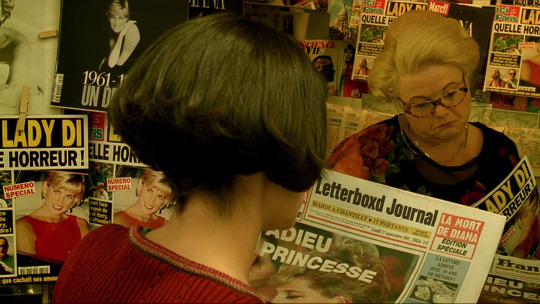
Letterboxd news is now on Journal.
From today, we’re transitioning our news and editorial coverage to our own website. You’ll find the entire Tumblr archive recreated over there, along with topic-based sections, author archives and more. From today, we won’t be publishing any further news on this blog. Please follow our new Journal RSS feed, if that’s your thing, or visit our new editorial homepage:
Journal—Letterboxd’s home for news and editorial coverage
21 notes
·
View notes
Photo
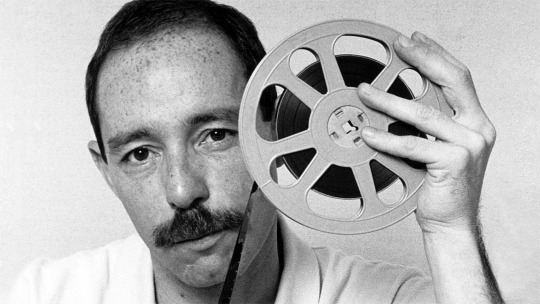
He Was Here.
On the anniversary of Vito Russo’s death from AIDS, filmmaker Jenni Olson remembers the activist and author, who helped so many—including Olson herself—crash out of the celluloid closet.
Back in 1986, when my film studies professor handed 23-year-old me a copy of Vito Russo’s book, The Celluloid Closet, little did I know how life-changing it would be. I would go so far as to say that Vito’s powerfully written analysis of the history of homosexuality in the movies actually saved my life.
First published in 1981, The Celluloid Closet covered the history of LGBTQ representation on screen since the dawn of motion pictures. Vito wrote about films as far back as Richard Oswald‘s 1919 Anders als die Anderen (Different from the Others), the German film considered to be the first gay feature, and Mädchen in Uniform, the beautiful and surprisingly political 1931 German drama considered to be the first lesbian feature.
Covering more than a hundred movies, the book spanned all the Hollywood stereotypes: the proto-gay sissies like Franklin Pangborn and Eric Blore in the 1930s; the creepy coded predatory lesbians of the 1940s and 1950s (like the prison matron in Caged); sensational trans depictions like I Want What I Want and The Christine Jorgensen Story, and half-lurid, half-comical bisexual tales such as A Different Story.
Vito revisited the book towards the end of the 1980s, incorporating some more recent achievements of the time, like the Academy Award winning documentary, The Times of Harvey Milk and beloved LGBTQ indie classics like Donna Deitch’s Desert Hearts and Bill Sherwood’s Parting Glances. (There is, naturally, at least one Letterboxd list of all the films in this revised edition.)
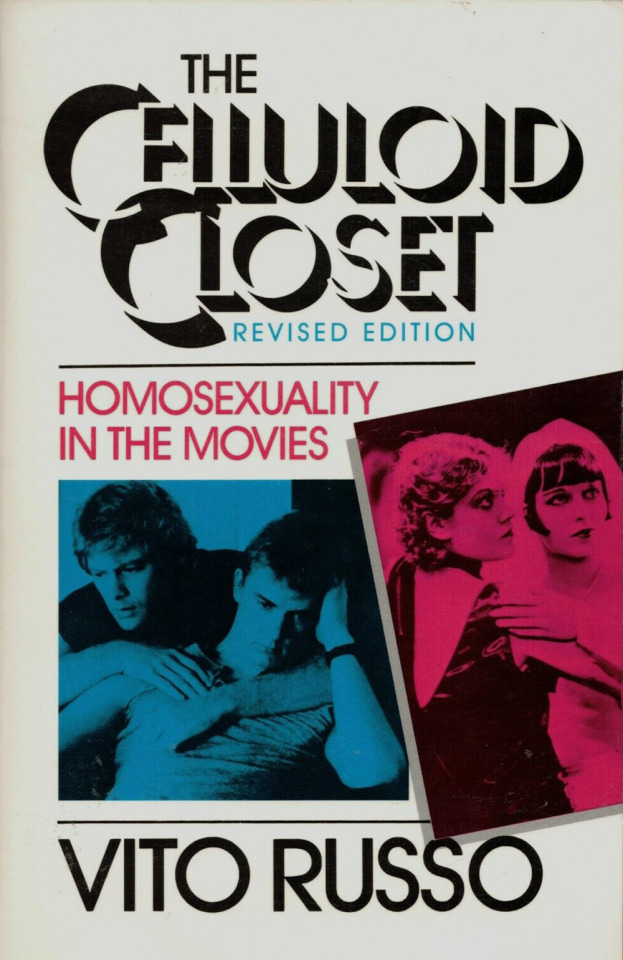
When The Celluloid Closet landed in my hands, I had been miserably stumbling along in college, and in life, for the previous five years. Vito’s book was the catalyst for my coming out to myself as queer (I wanted to see all those movies he wrote about) and for coming into the LGBTQ community (I imagined everyone else might want to see those movies too).
And so, despite having zero experience in how to do it, I started a weekly queer film series on campus, which brought hundreds of people out to the movies each Wednesday night. While there were certainly LGBTQ stories being told on screen in 1986, it was still an era where these films were much harder to access. Some were shown on television or available on VHS tape, but often these films had to be seen at film festivals or arthouse theaters.
The very first films I programmed in that series included some titles that remain among my favorite LGBTQ movies of all time: the aforementioned Mädchen in Uniform; the wonderfully romantic, 1968 French schoolgirl drama Therese & Isabelle; and jumping ahead to the indie gay films of the 1980s, Arthur J. Bressan’s devastating AIDS drama, Buddies (1985).
A few years later (with my University of Minnesota film studies BA in hand), I jumped in to become co-director of Frameline in San Francisco, the oldest and largest LGBTQ film festival in the world, and carved out a queer corner of the internet for movie lovers, co-founding the massive LGBTQ movie database, PopcornQ (aka “the gay IMDb”) as part of the world’s first major LGBTQ website, PlanetOut.
Along the way, I also worked as a queer-film critic, queer-film historian, queer-film collector, queer-archival researcher, queer-consulting producer (most recently on Sam Feder’s acclaimed overview of trans lives on screen, Disclosure), and spent a decade driving the marketing efforts of the oldest and largest LGBTQ film distributor in North America (Wolfe Video). And I made some films myself. (Yes, there is a Letterboxd list!)
At some point, Vito and I became friends. More than that, he became my mentor. He instilled in me a passionate belief in the power of LGBTQ cinema; in all the ways that films can give us the support and compassion, the inspiration and validation, the respect and dignity, the complexity and nuance, the joy and entertainment that we need and desire. And yes, even the messy and fucked-up representations, too. (Be gay, do crime, etc.)
Vito died of AIDS on November 7, 1990. As the 31st anniversary of his passing approaches, I’ve been thinking a lot about leadership, both personal and collective, and how we make positive change.
In addition to his groundbreaking work on that life-changing book, which was made into the tremendous, must-see 1995 documentary The Celluloid Closet, Vito had long been an important gay activist in New York City, eventually co-founding ACT UP in 1987.
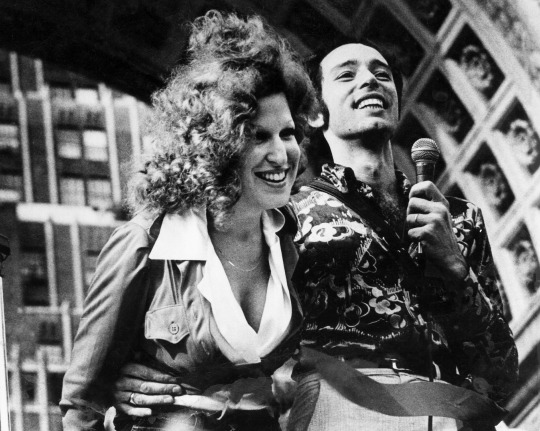
Russo with Bette Midler at the 1973 Gay Pride Rally in Washington Square Park, New York.
Vito was also one of the founders of GLAAD, the US-based LGBTQ media advocacy organization dedicated to (among many other things) improving LGBTQ representation in film and television. Since 1985, GLAAD has had an enormous impact in transforming the on screen landscape with regard to LGBTQ characters and stories, cast and crew, coverage and visibility of queer cinema.
This year—this is such a beautiful and deeply moving thing for me—Vito’s mentorship came full circle. I now work for GLAAD. It is my actual job, every day of the week, to carry on his legacy.
As director of our Social Media Safety program, I advocate for LGBTQ user safety around content moderation, data privacy, problematic algorithms and other forms of tech and platform accountability (yes, including Letterboxd). I also get to be involved in some of GLAAD’s other media advocacy work.
One of the most impactful things that GLAAD produces each year is the Studio Responsibility Index, which evaluates each of the major Hollywood studios and serves as a road map toward increasing fair, accurate and inclusive LGBTQ representation in film. There’s an equivalent publication covering the television industry: the Where We Are On TV report.
GLAAD’s most public media advocacy work is the annual GLAAD Media Awards, honoring fair, accurate and inclusive representations of LGBTQ people and issues in film, television and other media. (Submissions are open until December 7, 2021—if you’ve made something, make sure we know about it.)
Every year the event honors Vito’s legacy with the presentation of the Vito Russo Award to an openly LGBTQ media professional who has made a significant difference in promoting equality for the LGBTQ community. Recent recipients include George Takei, Billy Porter, Samira Wiley and Ryan Murphy.
In an interview with Making Gay History author and podcast host Eric Marcus, Vito talked about the legacy he wanted to leave, citing Spanish filmmaker Pedro Almodóvar.
“He said, the thing is, is you can’t regret your life, otherwise why did you live? What was the point of having a life if you didn’t say something or do something that was gonna survive after you’re gone… I really feel the reason why I’m here is so that I could leave this book and these articles so that some sixteen-year-old kid who’s gonna be a gay activist in the next ten or fifteen years is gonna read them and carry the ball from there.”
I love the thought of how amazed Vito would be if he could see what LGBTQ representation on the big screen looks like today compared to where we were when GLAAD was founded 36 years ago—in large part because of his leadership.
Let me just shout out a few Letterboxd lists that so vividly illustrate this point: Intersex, LGBT POC, Films featuring LGBTQ characters/folks with disabilities, LGBT+ films from Southwest Asia and North Africa, TRANS, South Asian LGBT, Directed and/or written by transmascs and trans men, Todos Me Miran: The Queer Latinx Experience. And hey, if the movie list you want—or indeed the movie—doesn’t exist yet, may this be the inspiration that prompts you to create it.
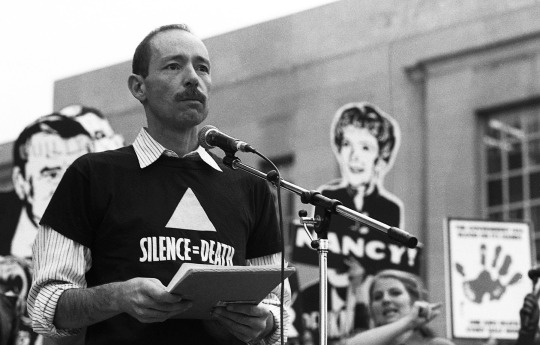
Activist and author Vito Russo. / Photo by Rick Gerharter/HBO Documentary Films
You can learn more about Vito in Jeffrey Schwarz’s beautiful 2011 documentary, Vito. And, you could begin applying GLAAD’s Vito Russo Test to your movie-watching habits. Briefly: a film must include an identifiable LGBTQ character; who is not solely defined by their sexual orientation or gender identity; and, the character must matter to the plot. This short video on GLAAD’s YouTube channel explains it more—there are already many Vito Russo Test lists scattered across Letterboxd.
Lastly, follow GLAAD’s brand new Letterboxd HQ account, where you can discover some of the best LGBTQ films of the past few decades via our lists of GLAAD Media Award Winners. A quick name drop of a handful of those honorees over the years just to whet your appetite: The Wedding Banquet, Pariah, Go Fish, Brokeback Mountain, Moonlight, The Incredibly True Adventures of Two Girls in Love, Call Me by Your Name.
Grazie, Vito!
Related content
World AIDS Day is December 1—Here’s a Letterboxd list of films that ensure we never forget.
Rebel Dykes, a documentary mash-up of animation, archive footage and interviews about a radical lesbian subculture in 1980s London, opens in UK and Irish cinemas from 26 November (US release TBA)
All the Good Boys: Schlockvalues’ essay for Letterboxd on the real roots of queer cinema and the evolution of gay masculinity on screen
14 notes
·
View notes
Photo
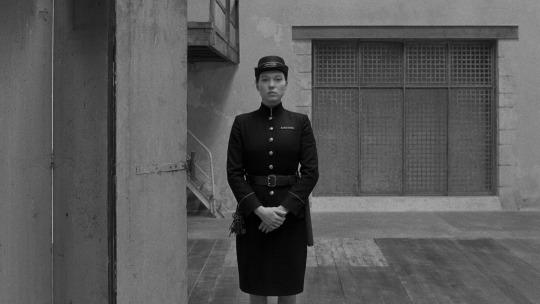
Free Form.
London correspondent Ella Kemp talks to The French Dispatch and No Time to Die star Léa Seydoux about being part of Wes Anderson’s “little troupe”, the best Parisian films, and baring it all.
“I’ve always thought that showing your emotions can also be very disturbing. In front of a camera, I always feel naked.” —Léa Seydoux
The first thing you notice about Léa Seydoux in Wes Anderson’s The French Dispatch is, well, all of her. She appears in the first of the film’s three chapters as Simone, a prison warden, who develops a curious relationship with inmate and painter Moses Rosenthaler (a beguiling Benicio Del Toro). It’s a striking role that stands out in a film defined by just how many different moving parts it has.
She is also a stand out—the beating heart, really—in No Time to Die, Daniel Craig’s last turn as James Bond. As psychologist Madeleine Swann, Seydoux makes history by holding on long enough as a Bond girl (alive and kicking at the end of 2015’s Spectre) to make it into the follow-up film (and therefore benefit from a Bond girl rarity: further character development).
History-making is a habit: in 2013, Seydoux and her Blue Is the Warmest Color co-star Adèle Exarchopoulous became the first actresses to be awarded a Palme d’Or, alongside their director Abdellatif Kechiche. The three-hour romantic odyssey was notorious and somewhat divisive for its intense, exhaustive sex scenes and reports of less-than-enjoyable working conditions for its stars, and the Cannes jury saw fit to include “all three artists” in its decision.

Léa Seydoux as Madeleine Swann in ‘No Time to Die’.
Which leads us back to Simone and The French Dispatch. Seydoux’s only clues about her character were a handful of lines, which, considering so much of Simone’s aura is conveyed through body language, can’t have given much away. She started to get the sense of the story after travelling to Angoulême, where Anderson had already begun filming, to hear from the magician himself.
Having worked with Anderson before, as Clotilde in The Grand Budapest Hotel, Seydoux was ready for the moment he presents his cast and crew (she calls them “a little troupe”) with intricate, animated films to offer a précis on the world they’re about to build. “He does all the voices and they’re absolutely stunning,” the actress explains. “It was then that I realised how beautiful and poetic this character was.”
Beautiful, poetic, and, without spoiling the impact of her first frame, quite starkers. Simone’s is a scene that, even in such a formally composed film as this, raises questions yet again about the way we—the audience, the director, the painter—look at the female body on screen. Who chooses how close we get? How long we linger? And how does the woman whose body is being observed feel about it all?
“I didn’t necessarily feel confident,” Seydoux says when asked what gave her the faith that she would be in safe hands for such a revealing role. “It’s not necessarily comfortable to be naked in front of the camera, but it’s also not necessarily comfortable to act. I’ve always thought that showing your emotions can also be very disturbing. In front of a camera, I always feel naked.”

Benecio Del Toro (center) as Moses, and Seydoux (right) as Simone in ‘The French Dispatch’.
Still, it is always curious to consider how it comes to be that certain roles require baring oneself more than others, and how certain actors come to choose those roles—particularly in the time of intimacy coordinators, safety considerations, and film-industry campaigns for equality and diversity such as Collectif 5050x2020, of which Seydoux is a founding signatory.
“I know it’s something that exists, but we don’t really have intimacy coordinators in France,” Seydoux says of her experience working in such delicate environments. She explains that she always approves of the scene after filming by watching it back on the monitor herself, but then shrugs, “That’s all.”
But that’s not all. With a few minutes left of our chat, we questioned Seydoux on some of her movie loves. Her answers reveal favorite female muses, visionary auteurs, and why she chose a life in front of the camera.
What’s your favourite Wes Anderson film?
Léa Seydoux: The Royal Tenenbaums.
Could you give us a few films set in France that you feel honor the country beautifully?
I love The 400 Blows, it’s so beautiful. But there are so many wonderful films set in Paris. I love Éric Rohmer’s films, and there’s one set in Paris called Love in The Afternoon, which is beautiful.
Who is your favorite “female muse”?
I love Anna Karina as an actress, but also as a muse and an actress I love Elizabeth Taylor. A Place in the Sun is my favorite.
What is your favourite black-and-white movie?
The Kid by Charlie Chaplin.
And your favorite James Bond film?
Casino Royale.
Which contemporary filmmaker do you think and hope might have a similar legacy to Wes Anderson, in terms of having an unusual artistic vision?
Joachim Trier.
What was the first film that made you want to be an actress?
I don’t think I want to be an actress! No, to be honest, I didn’t want to become an actress because I saw a film. It was more actors who made me want to be an actress, because I just wanted to be my own master. And I loved the fact that actors were very free in the sense that they can choose whatever they want. It was because I wanted to be free that I became an actress.
Related content
Sarah Williams’ list of feature-length French films by women
After Agnes: Ten French Filmmakers to Watch in 2021
Paris, Je T’Aime: the Letterboxd Showdown of the best films set in or about Paris
‘The French Dispatch’ and ‘No Time to Die’ are screening in cinemas in the US, UK and further countries now.
6 notes
·
View notes
Photo
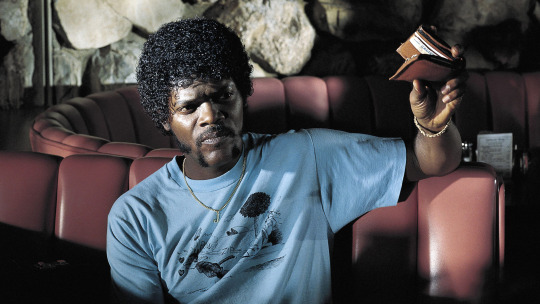
One Good Motherf**ker.
Editor-at-large Dominic Corry introduces an exclusive excerpt from Gavin Edwards’ new book about the life and work of Letterboxd’s most-watched actor, and the Samuel L. Jackson films we never got to see.
Like his wallet in Pulp Fiction reads, Samuel L. Jackson is a bad motherf—ker. In a good way. He’s about the coolest damn actor wandering the Earth these days, and he’s unleashed that cool in more than a few films, 140-odd in fact. And you watch a lot of them. For almost every year of Letterboxd’s first decade, Samuel L. Jackson has been the Most Watched Actor in our Year in Review.
But don’t just attribute that to his presence in the Marvel Cinematic Universe, in which he plays the semi-ubiquitous Nick Fury—he still wins even when we exclude his cameo roles. Jackson’s complete and total dependability sees him in constant high demand because he always delivers, in a wide range of genres.
Relentlessly versatile while always giving you something familiar, he balances movie-star charisma and consistency with character-actor panache. His stage-trained projection brings gravitas to every performance, but Jackson somehow never pushes it over the top.
He’s also really good at saying “motherf—ker” and its variations (a long list of every utterance can be found here), so much so that Snakes on a Plane famously staged reshoots to satisfy test-audience demands that Jackson utter the expletive in the movie.
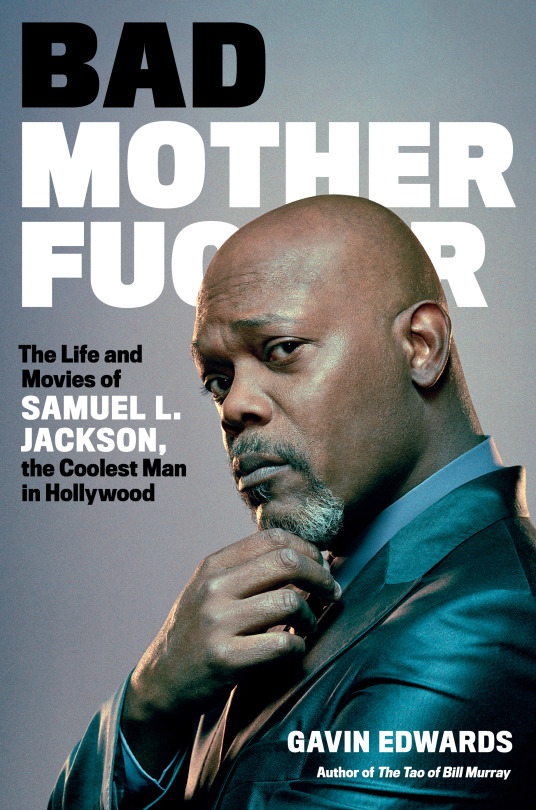
He said it 21 times as the splendidly serpentine Ordell Robbie in Jackie Brown in 1997, and twenty times in the 2019 Shaft movie. He almost ran it into the ground by making “a thing” out of saying the word in The Hitman’s Bodyguard (nineteen, most with a wink), but Jackson has enough goodwill by this point to forgive such transgressions. Here’s to many motherf—kers more.
So it makes sense that Gavin Edwards’ new book about Jackson’s life and career is titled Bad Motherf—ker. In addition to a deep dive into all of Jackson’s performances, Edwards also lays out some of the roles he came close to taking, but didn’t (Jackson as Buck in Boogie Nights!? It could’ve happened!), and some other Samuel L. Jackson projects that never got made at all. Speaking of which, we’re still waiting for that long-promised Blob remake, Sam.
Some of those fascinating what-ifs (Michael Caine as butler to Jackson’s jazz musician in New Orleans!?) are covered in an exclusive excerpt from Edwards’ book, reproduced below courtesy of Hachette Books, along with details of Jackson’s involvement in the bizarre animated epic Quantum Quest: A Cassini Space Odyssey, which, despite boasting a bunch of huge names in the voice cast, hasn’t really been properly released in English-language territories. “Someone needs to find this ASAP,” demands Mody. The excerpt indicates that Netflix and Amazon have shown interest, so maybe exposure in this book can inspire a streamer to finally put it out there. We’d like to see it. (You can watch the trailer, at least.)
Jackson couldn’t be in every single movie that got released, but it wasn’t for lack of trying. His appetite for work being what it was, and Hollywood being the fickle type of industry that it is, he was attached to plenty of projects that got announced but never happened.
A handful of the most intriguing: Truck 44, about firemen who rob a building by setting fire to it, was canceled after 9/11. In the comedy Man That Rocks the Cradle, Jackson would have played a live-in nanny. Black Phantom would have starred Jackson and Kevin Hart as double-crossing hit men. George C. Wolfe wanted to direct an update of the 1961 Danish film Harry and the Butler, where Jackson would have played a New Orleans jazz musician and roller-coaster mechanic who falls on hard times and lives in a converted train caboose—but when he inherits a big chunk of money, he hires an out-of-work British butler (Michael Caine).
He also turned down some movies that went on to be hits with other actors, such as Kiss the Girls, a thriller where Morgan Freeman ultimately costarred with Ashley Judd. “Too misogynistic,” Jackson said. Paul Thomas Anderson invited Jackson to play Buck Swope in Boogie Nights, but Jackson had already committed to another film; the role went to Don Cheadle (who also starred in Hotel Rwanda when Jackson passed on that script). Jackson was attached to The Matrix for years but got tired of waiting for the Wachowskis to make the movie happen, so he took other work; when he was unavailable, they cast Laurence Fishburne as Morpheus.
Weirder than any of those never-happened projects was an animated film that was over a decade in the making (and depending on how you think about it, still might not be finished): Quantum Quest: A Cassini Space Odyssey. Co-director Harry Kloor was a double PhD (in physics and chemistry) who had a personality better suited to Hollywood than the academy; he touted his multiple black belts in modern martial arts and his Nissan 300ZX Twin Turbo sports car. Kloor wrote for the TV show Star Trek: Voyager—and in 1996, he was approached by NASA and JPL to see if he could make an educational film about the Cassini-Huygens mission (a probe, launched in 1997, that ended up in orbit around Saturn to collect massive amounts of data on the gas giant and its rings).
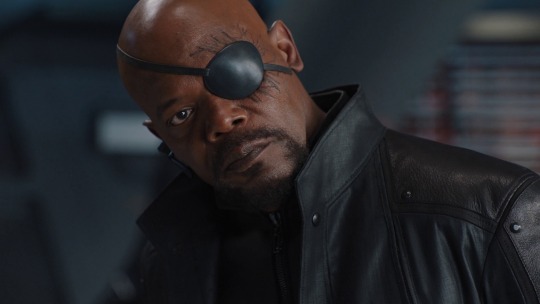
Samuel L. Jackson as Nick Fury in the MCU.
The NASA boffins wanted to do a movie about the journey of a photon, taking a million years to go from the core of the sun to the surface, then eighty-seven minutes to travel through space to bounce off Saturn and reach the Cassini probe. Kloor convinced them that while they might be fascinated by this journey, it wouldn’t particularly appeal to kids: Why not turn the photon and other scientific concepts into colorful characters and make an animated movie? NASA bought the pitch, giving him $100,000 in seed money.
Kloor wrote a script for a sixty-five-minute educational movie, called Quantum Quest, about the adventures of Dave the Photon; working all his contacts and leaning hard on the educational angle, Kloor recruited an improbably high-caliber cast of Hollywood talent who worked for scale, recording voice performances for under a thousand dollars each, including John Travolta, Christian Slater, Sarah Michelle Gellar, James Earl Jones, and Samuel L. Jackson. Then NASA revised their plans: they wanted the movie to incorporate actual images from the Cassini-Huygens mission. The probe wasn’t reaching the neighborhood of Saturn until 2004, however, and it would take years to get usable data after that. Essentially, Kloor said, they wanted him to wait a decade before he made the movie.
So Quantum Quest went into hibernation until 2007, when Kloor recruited a co-director experienced in animation, Daniel St. Pierre, and found a studio in Taiwan called Digimax that provided a substantial production budget. Kloor gave the seed money back to NASA with a return on investment. “It’s the only project NASA’s ever made a profit on,” he bragged. “They put a hundred K in and they got two hundred K back, and for years, they kept calling me to say, ‘Something’s gone wrong, because we got more money.’ ”
Digimax had no animators, so St. Pierre spent many months in Taiwan, teaching its employees the necessary skills, “training a studio to make this film.” The company wanted to do a full-length feature, so Kloor heavily revised his script, expanding it to around one hundred minutes. That meant returning to his actors a decade later and asking them to record new dialogue: most declined (or were never even told about it by their agents). Undeterred, Kloor recruited a second cast, including William Shatner, Mark Hamill, Jason Alexander, Amanda Peet, and Chris Pine. Jackson was one of the few actors to stay with the project.
“Unlike a lot of other people, Sam immediately said, ‘Yeah, I’ll do it,’” Kloor said. “I think Sam truly cares about kids and he loves science fiction.” In both versions of the script, Jackson played a character called Fear, a sentient embodiment of antimatter and the general of the armies of evil, in the service of a villain called the Void. Jackson was agreeable and generous on the day he came to do his voice recording—although he did nickname St. Pierre “Four Eyes” and mock Kloor mercilessly when the writer made the mistake of suggesting a line reading.

Samuel L. Jackson’s ‘Quantum Quest’ character, Fear, a “sentient embodiment of antimatter”.
Back in Taiwan, the filmmakers edited the material together and worked on character design. St. Pierre said, “The way Sam played Fear was quite serious; he has a sharp, thorny aspect to him. So we put these spikes that could grow out of his shoulders and back and the more excited and agitated he got, the more these spikes would grow.”
They were about to start animating Quantum Quest when St. Pierre was called into an executive meeting: Digimax wanted to cut the movie down to forty-three minutes. (Digimax was funded by the Taiwanese government; as far as Kloor and St. Pierre could tell, the company fell victim to local politics and had its budget unexpectedly slashed.) They cut the movie to the bone, ending up with forty-nine minutes plus credits. Digimax had the distribution rights in Asia and released the movie there: St. Pierre and Kloor believe it did well in those territories but have no hard data.
In the United States, they had an odd property: a star-studded movie too short to play multiplexes but not educational enough to be booked at most science museums. And the animation, reminiscent of the video game Skylanders, was uneven at best. “The Taiwanese team rose to the occasion to the best of their ability,” St. Pierre said. “I have nothing bad to say about the artists and technicians.” In one more feat of recruiting, they signed up Jon Anderson (of the band Yes) to perform the movie’s theme song, “Sing.”
The movie played at a few IMAX theaters, including the screens at the Saint Louis Science Center and the Kentucky Science Center, and then vanished, although it remained available to be booked by educational institutions. Kloor says the movie’s target audience is “kids in the third, fourth, fifth grade—or college students who are stoned.” In the streaming era, Quantum Quest became newly valuable and Kloor has been approached about getting it onto Netflix or Amazon—maybe even restoring it to its intended length. “It would cost a fraction of what people normally spend to have a full-length feature,” he pointed out.
The Cassini probe was destroyed in 2017, burning itself up in the upper atmosphere of Saturn so it wouldn’t contaminate any of the planet’s moons. If Quantum Quest ever gets completed as a feature film, it will have had a journey even longer than the plutonium-powered orbiter. Its saga is a useful reminder that every single movie Jackson has appeared in has required extraordinary effort by countless professionals across a period of years, which makes it even more extraordinary that he’s been in over 140 of them.

Samuel L. Jackson in ‘Snakes on a Plane’ (2006).
Years later, St. Pierre still remembered the advice Jackson gave kids when the filmmakers interviewed him on camera. “Read as much as you can, whatever you can, all the time,” Jackson said. “Fill your mind with thoughts and ideas and other people’s words and philosophies.”
The reason Samuel L. Jackson liked to read was the same reason he liked to act: it was escapism that took him away from his own too-familiar identity, at least for a little while. So he was an avid reader his entire life, favoring science fiction and thrillers and comic books.
Phil LaMarr, who appeared with Jackson in Pulp Fiction, periodically ran into his fellow actor at the Golden Apple comic-book shop in Los Angeles.
LaMarr remembered a day when he was browsing in the adult section of Golden Apple, with his back to the curtain that separated it from the kid-friendly titles. He was interrupted by a familiar voice: “A-ha! Caught you!”
“Oh, goddamn you,” LaMarr thought when he turned and saw Jackson. “When you’re looking at the Milo Manara stuff, you’re not really in a conversational mode.”
The store’s main room, on the other side of the curtain, contained a full array of superhero comics, including Marvel titles that featured Nick Fury. Jackson was fourteen years old in 1963, when Fury debuted in Marvel comic books in Sgt. Fury and His Howling Commandos #1.
Nick Fury had an eye patch; he chomped on cigars; sometimes he led a squadron in World War II and sometimes he commanded the immensely powerful spy agency SHIELD. But whether he was drawn as a square-jawed war hero by Jack Kirby or with secret-agent op-art stylings by Jim Steranko, he was a white guy. When the character appeared in a TV movie that aired on Fox in 1998, Nick Fury: Agent of S.H.I.E.L.D., he was played by David Hasselhoff.
That changed in 2001, when Nick Fury appeared in Marvel’s Ultimates line, wherein Marvel rebooted their entire continuity, discarding decades of storylines and reimagining favorite characters.
From ‘Bad Motherfucker: The Life and Movies of Samuel L. Jackson, the Coolest Man in Hollywood’ by Gavin Edwards, courtesy of Hachette Books, on sale now. For more on ‘Quantum Quest’, see the film’s website.
#samuel l jackson#pulp fiction#nick fury#marvel studios#marvel cinematic universe#mcu#bad motherfucker#letterboxd#agent of s.h.i.e.l.d.
5 notes
·
View notes
Photo
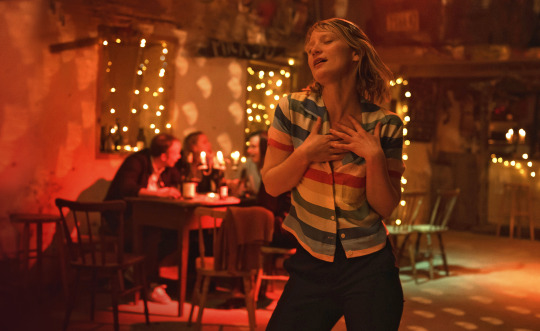
Fårö and Away.
Away from the breathtaking island of Fårö, Letterboxd’s East Coast Editor Mitchell Beaupre speaks with Bergman Island filmmaker Mia Hansen-Løve about all things Bergman, finding the balance between your art and your relationships, and the sex appeal of Elliott Gould.
“I think one of the first things that made me love the films of Bergman is the way he films women, actually… Who can pretend to have filmed women better than he did?” —Mia Hansen-Løve
Fårö, an island in the Baltic Sea off Sweden’s south-eastern coast, is a popular summer vacation spot, with its own language (a dialect of Gutnish called Faroymal). It was also the home of the great filmmaker Ingmar Bergman, who fell in love with the island once he set foot on it in 1960. He made many films there, including Through a Glass Darkly, Persona and Hour of the Wolf, eventually staying there for the final years of his life, until his death in 2007.
Since his passing, Bergman’s estate on Fårö has been turned into an artists’ retreat where guests can now visit and stay at the place Bergman called home. There you can visit the Bergman Center, a cultural destination for those seeking to celebrate the filmmaker’s art and life. Each year, the center hosts a five-day event called Bergman Week, where films are screened alongside discussions, music and lectures. Special guests for Bergman Week over the years have included Yorgos Lanthimos, Harriet Andersson, Greta Gerwig, Noah Baumbach, Tim Roth and Mia Hansen-Løve (writer and director of Goodbye First Love and Things to Come).
Hansen-Løve’s affinity for Fårö and for Bergman’s work made the island the natural location for her latest feature, appropriately titled Bergman Island. The film stars Vicky Krieps as Chris, a filmmaker who arrives on Fårö with her husband Tony (repeat Fårö visitor Tim Roth). Tony is the more accomplished filmmaker of the duo, and is being showcased on the island. As their time there continues, Hansen-Løve blurs the line between fiction and reality for both the audience and the characters, charting a metafictional course that sees Chris’ art inspired by her life, just as Bergman Island is inspired by Hansen-Løve’s.
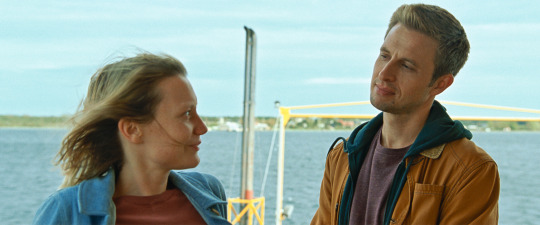
Mia Wasikowska and Anders Danielsen Lie in ‘Bergman Island’.
After a rocky production, which saw actors Greta Gerwig, John Turturro and Owen Wilson all cast in the leading roles at various points before having to drop out, Bergman Island made its premiere at this year’s Cannes Film Festival, before going on a run that included stops at Telluride, TIFF and NYFF.
With its fondness for Bergman permeating through each scene, and a cast that also includes Mia Wasikowska and Anders Danielsen Lie, “this one is surely for the Letterboxd users”, Ethan writes in his review. A look through other reviews proves Ethan’s statement largely correct. Ash appreciates the way Hansen-Løve finds inspiration from Bergman to tell her own story, as opposed to being a more direct homage. For Jervis, it was “everything I love in art”. And, of course, it must be said: this has truly been quite the “big year for Vicky Krieps and beaches”.
As Bergman Island at last reaches audiences beyond festivals, Hansen-Løve sat down with Mitchell Beaupre to discuss her relationship with Bergman’s work, with Fårö itself, and how this film allowed her to reach a new level of maturity in her filmmaking.
What was the first Ingmar Bergman film you saw, and what was your response to that introduction to his work?
Mia Hansen-Løve: I think I was in my twenties when I first saw films by him. There was a retrospective of his work at an old historical cinematheque in Paris. The very first one I saw was Summer with Monika, one of his early films. The Nouvelle Vague guys at that time elected that film as being the symbol of modern cinema because Bergman was filming young people in love in a way that was different to what had been shown on film before then.
It wasn’t shot in Fårö, I think it was shot in the archipelagos of Stockholm, but he was shooting outside locations, which was also quite unique. It was breaking all the rules in terms of what cinema was doing, in terms of how these young characters were living, and especially about the way he filmed women. I think one of the first things that made me love the films of Bergman is the way he films women, actually.
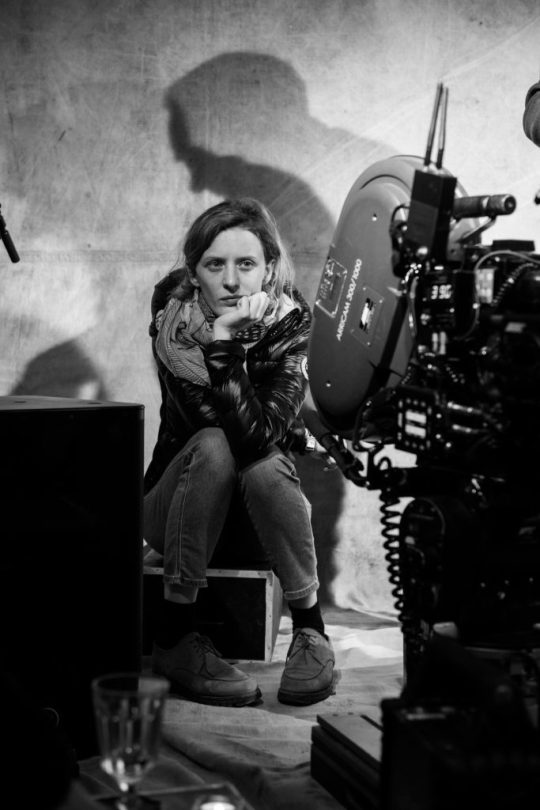
Director Mia Hansen-Løve on the set of ‘Bergman Island’.
Some people have felt that Bergman Island suggests Bergman was a bit sexist, but you actually feel quite the opposite.
Yes, the comments in my film on the way he behaved with his kids has led to people thinking I’m criticizing his relationships with women, but I actually admire him for being one of the directors who filmed the most beautiful portraits of women ever in cinema. Who can pretend to have filmed women better than he did? That’s one of the things that makes his films so significant to me—how much importance he gave to women at a time where most directors were giving that space to men in their films.
That would be enough, but then his films take up such a big territory for me because he’s made so many films, and all of them are made with the same independence and freedom. He wrote all of his films, and they all came from his desire to express something. They were never imposed from the outside. Few directors ever reached that same degree of integrity and independence, and I admire that so much.
Was there anything about his relationship with Fårö that connected with you personally?
He wasn’t the most social person, and that’s something that attracts me somehow in terms of his relationship with the island and what that means when it comes to loneliness. I cannot afford to live the way he did. I have a kind of life with family and obligations that make it impossible for me to live on a remote island. I wouldn’t want to live like that because I don’t have the strength, but I do admire that way of living, as he did for the last twenty years of his life.
You’ve said that while you don’t have a favorite Bergman film, you do have a special relationship with his 1971 film, The Touch. That’s a unique pick. What makes that film stand out so much for you?
I think it has to do with the fact that it’s not a cerebral film of his. It’s a film that I find very direct, very innocent, especially compared to other films he made in the same period. As a young director he made those films like Summer with Monika that were more direct, and also very sensual, and focused on love, relationships, passion, and things like that. But afterwards his films were more complex, and would tackle more aesthetic quests, more formal quests.
The Touch isn’t one of his most famous films. It’s been quite forgotten, and Bergman himself didn’t like it for some reason. What I like about it so much, though, is its simplicity. I find the film extremely sincere and incarnated. The presence of Elliott Gould in the film—an American actor—allowed Bergman to explore things about sexual relationships that he wouldn’t be able to say with his regular Swedish actors.
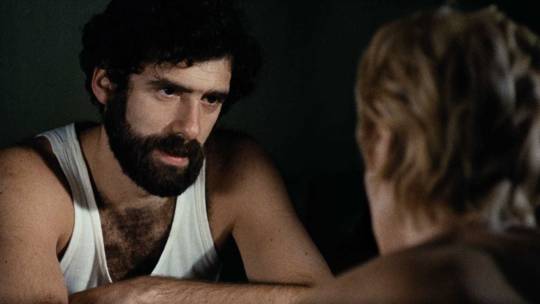
Elliott Gould and Bibi Andersson in Ingmar Bergman’s ‘The Touch’ (Beröringen, 1971).
There is certainly an innate sexuality that comes into play once you bring Elliott Gould into the mix.
He brought something in from the outside, with his American culture, his presence, charisma, sex appeal or whatever you call it, that was actually telling something from the inside to me. It’s very paradoxical, but I feel that Elliott Gould enabled Bergman to say something more about himself that his other films couldn’t say. There is something brutal and animalistic about him in the film, and I think that reveals something about Bergman himself. That actually moves me a lot, for some reason. The film touches me. I saw it again a few days ago, and it still has the same power for me.
It reminds me of some of Truffaut’s films that are about the power of passion in your life, and how it takes up all the space. The film shows that brutality of passion. I find that extremely powerful and beautiful, and I don’t know any other film of Bergman’s that’s like that.
Bergman Island focuses on two filmmakers who are in a relationship, and it makes interesting observations on the kinds of boundaries you have to set to be able to create while also being in a relationship with another person. It’s a difficult balance to navigate.
What I wanted to do with this film was to show the difficulty, and also maybe the beauty, of being in a couple where both are writers, or artists. They both have their own quest, yet they’re still trying to be together. What does it mean to be together and at the same time lonely? How do you find the balance between this necessary loneliness that comes with being an artist? Bergman incarnates that so perfectly—the loneliness, but also the power that comes with the solitude of an artist.
On the other hand, most human beings want to be in a couple because they want to have an exchange. They want to have a dialogue. They want to feel close to somebody. They want love. These are very universal, and human feelings that anybody can understand, but then how can you cope with that solitude of the artistic quest? My film really tries to deal with that.
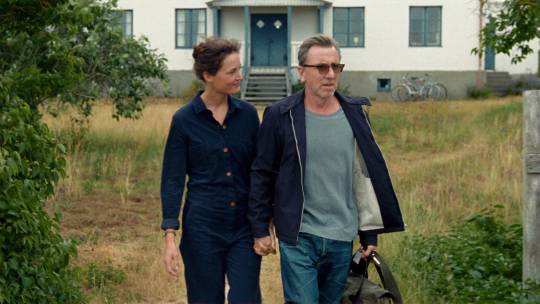
Vicky Krieps and Tim Roth in ‘Bergman Island’.
While the film is told from Chris’s perspective, there’s still a dimensionality to the portrayal of Tony, where he’s never seen as a villain, or an antagonistic force against her.
I don’t think the film wants to judge anybody. I didn’t make the film in order to go against the male character. I know there is more empathy in the film for her, because it’s more of a portrait of her, so we understand her more than him. He is more distanced from her, and that distance becomes more and more as the film goes on, as we get closer to her. I’m aware of that, but I never made the film against him. At the end, they are still together. I just wanted to show the difficulty and the vulnerability that comes when you are together, but lonely at the same time.
Navigating that relationship in the film must have been a little tricky, considering the production difficulties. You had several actors set to play Tony who dropped out, leading to you shooting half of the film with just Vicky Krieps, and not even knowing who was going to play Tony yet.
There was, of course, a challenge to shoot like this—to shoot only half of the film, and then have to wait to shoot the other half. We were editing certain scenes without even knowing who was going to play the husband. It was a little bit insane, a bit schizophrenic.
While it was challenging in some aspects, was there also a surprising benefit to doing it this way? Particularly given the nature of the film?
Yes, I think it’s a film that from the start was meant to take time. I’ve had this idea in my mind for more than ten years. Even before knowing I would set it on Fårö, the idea of making a film about a director couple was with me as I was doing other films. I let that film grow by itself until I found the idea of setting it on Fårö. It feels fitting that it would take me two years to shoot the film, and I’d have to leave and go back there.
I ended up going to Fårö each year for four or five years. I spent months on the island. I know every inch of the island now. I think that was part of the project. That’s the time I had to let pass in order to finish the film. That took a lot of patience, and that patience brought a maturity to the film. There is something peaceful and quiet about this film that makes it a bit different from my previous films.
Related content
Velma’s list of Scandi Films
Ingmar Bergman’s Fårö Island—a list of Bergman films shot on the island
Calvin’s list of Fårö Island filmography
Follow Mitchell on Letterboxd
‘Bergman Island’ is playing in US theaters now, and will be available on VOD from October 22.
5 notes
·
View notes
Photo
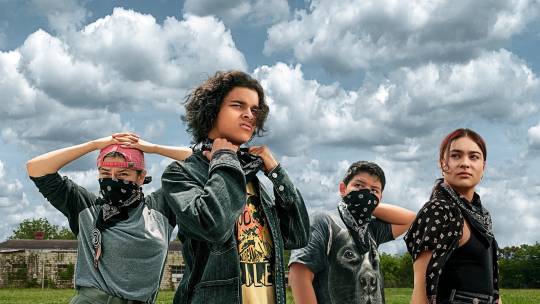
Reservation Roots.
For Indigenous People’s Day 2021, Leo Koziol explores the indie-film roots of Sterlin Harjo and Taika Waititi’s hit native series, Reservation Dogs.
Breakout FX on Hulu hit Reservation Dogs speaks directly to native audiences, each episode made lovingly by a bevy of native directors, actors and crew, many of whom found their storytelling voices through independent film. Anyone new to native cinema could do no better than to start their journey with a few choice cuts from these native talents.
The indie-film factor in Reservation Dogs’ success cannot be overstated. Television has a reach that other media do not, yet the path to primetime has never been easy. Any television project can die in development, fall at the pilot stage, or fail to be renewed after one measly season. For underrepresented storytellers, this road is even rougher.
To arrive on the small screen with a fully formed voice, there needs to have been a place to warm that voice up, and it’s more often been in the world of independent film that these opportunities lie for Indigenous artists.
Reservation Dogs is the brainchild of Taika Waititi (Te Whānau-ā-Apanui, Aotearoa) and Sterlin Harjo (Seminole/Muscogee Creek), who were both supported as indie darlings at Sundance under the watchful eye of recently retired native program director Bird Runningwater. (He has left the storied institute in order to produce his own projects.)
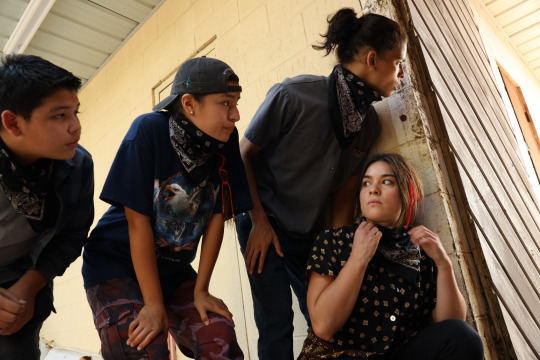
Lane Factor as Cheese, Paulina Alexis as Willie Jack, D’Pharaoh Woon-A-Tai as Bear, Devery Jacobs as Elora Danan Postoak in TV series ‘Reservation Dogs’.
Episodes were also directed by veteran natives Blackhorse Lowe (Navajo Nation) and Sydney Freeland, as well as performance poet and Bishop Paiute Tribe citizen Tazbah Rose Chavez (from the Nüümü, Diné and San Carlos Apache).
Between them, these five have made fifteen feature films (and won an Oscar), which represent a wellspring of native cinema ripe for rewatching or—going by many recent Letterboxd reviews who have come to them via Reservation Dogs—first-time discovery.
For aficionados of native cinema, Reservation Dogs is full of uniquely native humor (greasy fry bread, anyone?) and pop-culture references (main character Elora is named for the baby in Willow), but the most fun aspect for me has been the in-jokes. The Skux Soda cabinet at the native clinic (Hunt for the Wilderpeople fan service), a row of Māori dolls in a native rez store (co-creator Waititi is Māori) and, best of all, in episode five, an Oklahoma cinema marquee listing films by the four Native American directors of the series: Barking Water (Harjo), Drunktown’s Finest (Freeland), Fukry (Lowe) and Your Name Isn’t English (Chavez).
Waititi, the starrier of the two creators, whose feature works range from the awkward romance of Eagle vs Shark through to next year’s Thor: Love and Thunder, has certainly injected a careful balance of humor and emotion into the series. From his filmography, Reservation Dogs most resembles his 2010 semi-autobiographical comedy, Boy. But at heart, it is Harjo’s show—set in his home community of Oklahoma, and the culmination of fifteen years of filmmaking that serve as a calling card to its themes.
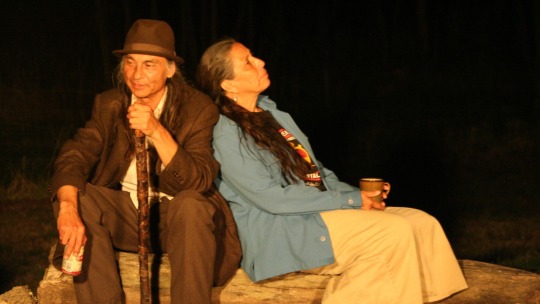
Richard Ray Whitman and Casey Camp-Horinek as Frankie and Irene in Sterlin Harjo’s ‘Barking Water’.
Stretching back to his beginnings, you can see two of Harjo’s best shorts on his YouTube channel. Goodnight Irene mirrors episode two of the series with malaise and humor in a native clinic; Three Little Boys directly mirrors the “kids on the Rez” ensemble of the show.
Then, in a trio of dramatic features, we see the progression as Harjo’s filmmaking skills grow alongside better budgets and resources. Letterboxd members are proudly noting the thematic similarities in his works. “Like Reservation Dogs, Harjo finds his most striking emotional moments in the quiet spaces between friends and family members,” writes Hannibal Montana of the first, Four Sheets To The Wind (2007).
CoterEB notes that Harjo’s 2009 follow-up, Barking Water, slots neatly into the Reservation Dogs storytelling family: “What Harjo absolutely succeeds at is letting the audience go along with it… It’s emotionally effective without manipulation.” It’s an approach that is further on display in his third feature, Mekko (2015), Hannibal Montana again recognizing that “much like Reservation Dogs, Mekko has one foot in a nostalgia for a lost, proud past and another in the immediate issues facing Indigenous people today, namely poverty, violence, and addiction”. (Hanabi Banana gives a more pointed review of this film, which I loved. Spoiler alert!)
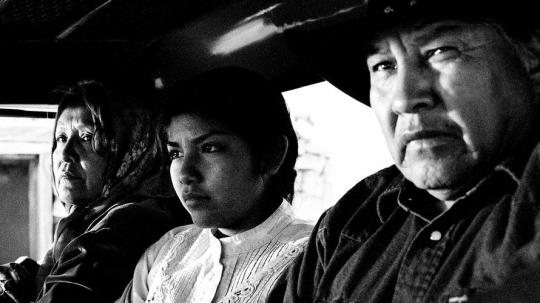
A still from Blackhorse Lowe’s 2009 short, ‘Shimásáni’.
Blackhorse Lowe is a long-time collaborator of Harjo’s; he was one of the editors of Mekko, and is also a Sundance alumnus. Lowe has a two-decade pedigree across many filmmaking departments and is a champion of genre-driven Indigenous films in New Mexico. His 2009 short Shimásáni is currently available on MUBI. He’s made three features, my favorite of which is Chasing The Light.
Writing about the 2014 film, Andy Nelson observes: “Lowe, also the cinematographer, captured some beautiful and haunting black-and-white imagery, which certainly helps add to the other world wanderings. It’s worth checking out, but the grittiness and raw drug comedy elements may be too much for a lot of people.”
I’m a huge fan of Lowe’s fellow Navajo director Sydney Freeland. You can watch her 2017 second feature, Deidra & Laney Rob A Train, on Netflix, but for me her best work to date is her first, Drunktown’s Finest (2014). Leonara Ann Mint writes of Freeland’s debut: “a very nuanced and powerful experience. Native American and trans voices are both way too rare in cinema, so to get both in the same film is often a revelation. All three plot lines here have depth, warmth and nuance, and by the end, the film had achieved a deep sense of emotional connectedness with each character that I won’t soon forget.”
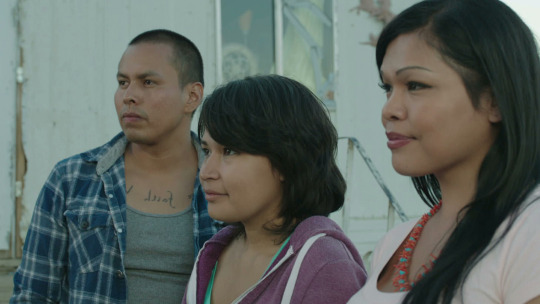
Jeremiah Bitsui, MorningStar Angeline and Carmen Moore in Sydney Freeland’s ‘Drunktown’s Finest’ (2014).
When Drunktown’s Finest was released, Freeland had not yet come out as a trans person (one of three stories in the Navajo-set film is of a trans woman, and how Navajo culture traditionally accepted those of a “third gender”). She’s gone on to cut a path in both LGBTQ storytelling and Indigenous film, and it’s wonderful to see her on the team for Reservation Dogs. Freeland is also directing episodes of Peacock’s Rutherford Falls, which shares creative talent with the Reservation Dogs collective. And with Harjo, she is making Rez Ball, a sports film for Netflix about the unique culture of Indigenous basketball.
In front of the camera, the ensemble cast of Reservation Dogs carries a film pedigree as deep as the directors behind it, and while many of the films they have appeared in are made by non-native writers and directors, their performances—and, in many ways their experiences on those sets—inform their work on Reservation Dogs.
Kahnawà:ke Mohawk actress Kawennáhere Devery Jacobs (credited as Devery Jacobs for her role as Elora) has played significant roles in Rhymes for Young Ghouls, the zombie outbreak gore-fest Blood Quantum and the Neil Gaiman series American Gods, as well as a number of short films, including Ara Marumaru for the Māoriland Film Festival Native Slam.
Dallas Goldtooth, who is Dakota and Dińe, appears on screen as the spirit of a warrior who died at Custer’s last stand. Goldtooth can also be seen as Rich Hall’s traveling companion in the comedian’s 2012 documentary re-examination of Native American stereotypes. Bear is played by Canadian actor D’Pharaoh Woon-A-Tai (of Oji-Cree, Anishinaabe and Guyanese descent) who has a breakout feature role in this year’s Beans, by Mohawk director Tracey Deer.
The cast also includes several veterans of the native film scene. First Nation media pioneer Gary Farmer, of the Cayuga Nation and Wolf Clan, has appeared in more than 50 films, including First Cow, Dead Man and Blood Quantum, and has been nominated three times for an Independent Spirit Acting Award.
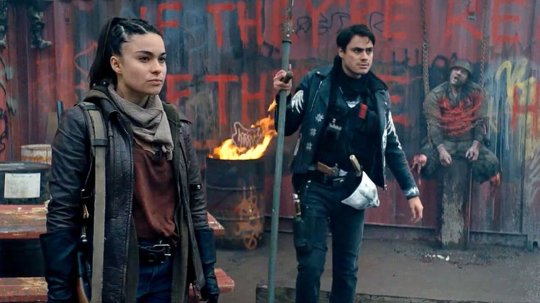
Devery Jacobs and Kiowa Gordon in ‘Blood Quantum’ (2019).
The legendary Cherokee star Wes Studi, who won an honorary Oscar at the 2019 Academy Awards, has had roles in numerous Hollywood blockbusters, including Dances With Wolves, The Last of the Mohicans and Avatar. My favorite Studi film is the comedy short, Ronnie BoDean, which you can watch for free on director Stephen Paul Judd’s Vimeo.
Nothing gets made without a script, and the brains in the Reservation Dogs writers’ room also have considerable roots in independent arts. Many of the crew, including Harjo and Goldtooth, are members of the 1491s, an Oklahoma-based native sketch comedy group. The 1491s are most famed for the 2019 Oregon Shakespeare Festival, where they premiered Between Two Knees, an intergenerational comedic love story/musical set against the backdrop of true events in native history.
1491s with writing credits on the show are poet and podcaster Tommy Pico (from the Viejas reservation of the Kumeyaay nation), Bobby Wilson (Sisseton-Wahpeton Dakota), who plays Marcus Werewolf in the What We Do in the Shadows television spinoff, and Migizi Pensoneau (Ponca/Ojibwe), who has several shorts on his filmography.
Right after the finale of series one, FX on Hulu announced Reservation Dogs season two and an expansion of its all-Indigenous writers’ room. Director Blackhorse Lowe joins the room, along with actors Jacobs and Goldtooth.
Other new writers in the room are Ryan RedCorn (Osage), who played Mike in Harjo’s Barking Water, Afro-Indigenous comedian and director Chad Charlie (Ahousaht First Nation), who made the 2020 short Uu?uu~tah and has another, Firecracker Bullets, coming next year, and award-winning writer-director Erica Tremblay (Seneca-Cayuga). Her 2020 short film Little Chief premiered at Sundance, and she is following in Waititi’s and Harjo’s footsteps as a Sundance Screenwriters and Directors Lab fellow.
The hope for both audiences and our industry is that Reservation Dogs won’t be a one-off. At the 2021 Emmy Awards, Harjo stood on stage and said, “We are here on television’s biggest night as creators and actors, proud to be Indigenous people working in Hollywood, representing the first people to walk upon this continent.”
Joined by his four leading actors, the group collectively stated: “Thankfully networks and streamers are now beginning to produce and develop shows created by and starring Indigenous people. It’s a good start, which can lead us to the day when telling stories from under-served communities will be the norm, not the exception. Because, like life, TV is at its best when we all have a voice.”
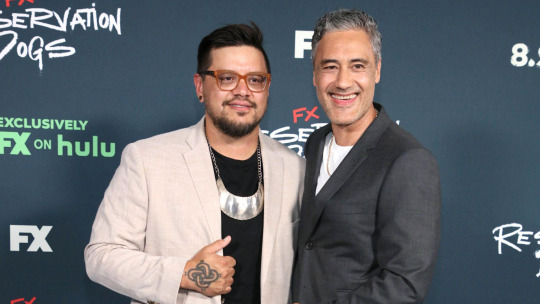
Sterlin Harjo and Taiki Waititi. / Photo by Robin Lori / INSTAR Images
As someone who for many years has followed the rise of native cinema from my home film festival, the arrival of this Stateside television hit marks a new day for native creatives. To Indigenous film fans, its creators are cult heroes who have been working for decades both in front of and behind the screen getting native American stories told, uncompromisingly.
I think about the collective talent that Sterlin and Taika have wrapped around the series, and I realize they simply contacted all their friends from past indie productions and said, hey, come work with us on this all-native production, we can pay you this time.
Related content
Leo’s list of the indie roots of Reservation Dogs
Reel Injun: a 2009 documentary by Catherine Bainbridge, Neil Diamond and Jeremiah Hayes about the Native American Hollywood experience
El Napalmo’s extensive Indigenous Cinema list
Dolores’ list of movies in which the main native character is in fact white
Beans is released in select theaters and on demand on November 5
Follow Leo on Letterboxd
#reservation dogs#taika waititi#sterlin harjo#tracey deer#beans#fx on hulu#rez dogs#leo koziol#maori movies#indigenous film#indigenous filmmaker#indigenous director#native american director#indigenous people's day
30 notes
·
View notes
Photo
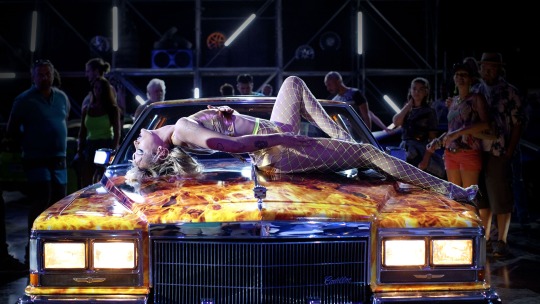
Driven to Love.
With the 2021 Palme d’Or winner in theaters now, Titane filmmaker Julia Ducournau speaks with Letterboxd’s East Coast editor Mitchell Beaupre about destroying societal expectations of gender, the unspoken nature of love, and finding art in a bunch of dancing firefighters.
“I wanted to get to the essence of the person, no matter what their gender is, their sexuality, no matter if they’re from the same family or not. That was the challenge for me, to see if I could make you feel the love.” —Julia Ducournau
Back in 2016, when writer-director Julia Ducournau delivered her debut feature Raw, audiences had no idea what they were in for. While no medical emergencies were reported at its Cannes Film Festival premiere, a Midnight Madness screening at TIFF resulted in ambulances being called in to treat multiple filmgoers who had passed out.
The film earned a mighty reputation, and that was only solidified once it emerged to the public. Perhaps Kat sums it up best: “I left the theater cackling, feeling energized and in love with cinema and life and women—and yet the film also made me anxious and worried and grossed out and violently sad.”
This extreme mixture of emotions wasn’t a one-off for Ducournau, who has followed up that lightning rod of a debut with perhaps an even more headline-grabbing sophomore feature. From the moment Titane debuted at this year’s Cannes, it was clear that it was going to be one of the most talked-about films of 2021.
Reactions out of the fest declared Titane “singular, shocking, repulsive and incendiary”, with Cronenberg comparisons aplenty for this body horror that seeks to reinvent how we see the human anatomy. The Cannes jury awarded the film the Palme d’Or, with jury president Spike Lee so eager to give it the prize that he misunderstood a question at the announcement ceremony and announced it prematurely.
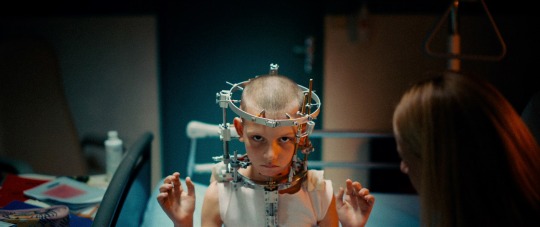
Adèle Guigue as seven-year-old Alexia in ‘Titane’.
The intense reactions out of Cannes were simply the beginning for Titane, which has gone on a barnstorming tour of just about every major festival this year, shocking and awing audiences along the way. Marking Ducournau’s return to TIFF Midnight Madness, Mav took some time to shout out the performances from Agathe Rousselle and Vincent Lindon, while Brittany wrote, “At times I had to watch through my fingers, at other times I was smiling ear to ear”. At NYFF, EJ spoke to the thrill of seeing the film in a theater with an audience “squirming, groaning, whimpering and (nervously) laughing”. Also, just in case you’re wondering, yes there have been more medical emergencies with this one.
Titane defies easy explanation; one can’t really give a brief plot synopsis without getting into spoiler territory. Abandoning the three-act structure, Ducournau’s film is constantly turning, ripping itself apart only to build back together as something entirely new in its explorations of a troubled young woman, Alexia (Rousselle), and a complicated firefighter, Vincent (Lindon).
Mitchell Beaupre straps in to speak with Ducournau about her unique approach to love, how Raw paved the way for her latest feature, and the fascinating arc she takes us on with her main characters.
According to just about everyone on Letterboxd who has seen Titane, you are essentially responsible for saving cinema in 2021. So many reviews are speaking of not only their love for the film, but the specific thrill of watching it in a theater with other humans, sharing intense reactions alongside other people. What does that mean for you to have created such a collective experience?
Julia Ducournau: For me, it’s not only meaningful—it’s essential. Titane and Raw were both crafted for the theater. This is in terms of image, obviously, but also with the sound, which is something very much less talked about that makes a huge difference. When you want to create a corporeal experience that is based on your bodily sensations, when you try to make the audience relate to the characters on that deeper level, the sound is something that helps a lot. That’s very specific to sound in the theater.
For example, something I use a lot with my sound designer and my mixer are sub [woofers]. I love subs because they make you feel the scene physically. You feel them through the floor, and you feel them in your chest. However, these subs can disappear very easily if they are not played with the specific amplifiers and sound system. It’s not something you will ever feel on your computer or on your TV, and obviously even less so on your phone. This is something totally linked to the theater experience, and a big part of the sensation I design for you to feel what my characters are feeling down to their skin.

Agathe Rousselle as the adult Alexia in ‘Titane’.
While the film is an extremely effective body horror, another thing we’ve noticed people engaging with more than anything else is the love at the heart of Titane. What compelled you to take audiences on this totally visceral journey that results in such an outpouring of and deep understanding of love?
Whew. That’s a bit hard to answer. I decided to put love at the center of Titane because when I was in post-production on Raw, I noticed that while love was present in the film, it was still a sidetrack. I actually began to wonder why I chose that, and if I felt that love was something I could express in a film.
I asked myself this question even more so when the idea is to make you feel what the characters are feeling. How do you make the viewer feel the sensation you have in your body when you love someone? That’s something incredibly difficult.
It was a very interesting challenge to try and aim at that, rather than to talk about love with words. For me, words tend to belittle the feeling a little bit, and also to belittle everything that this film embraces in terms of trying to see past all the presentations that the person in front of you might undergo.
I wanted to get to the essence of the person, no matter what their gender is, their sexuality, no matter if they’re from the same family or not. That was the challenge for me, to see if I could make you feel the love. If I could actually tackle the topic in the unconditional way that I see it. That’s why I decided to do Titane.
I must say, as a non-binary person myself, something that resonated for me personally was the queering of gender in the film. The way that you blur these lines between masculine and feminine, and call into question what those words even mean. How did you want to explore the idea of gender within the film?
At the start, it was about trying to have a character that broadens the spectrum of what gender means, but also what our humanity means. I wanted to show that there are a lot more options, and a lot more ‘gazings’ than we actually want to believe there is.
As I was writing the script, I also came to the conclusion that, for me, gender is not relevant in order to define someone. It’s only relevant in terms of societal expectations, which have nothing to do with the individual. I think that it is incredibly limiting to our comprehension of individuality, but also to our comprehension of the interactions we can have with others.
All I tried to do is put the audience in a position of growing empathy with my characters so they would accept the fact that my character is not just one, and she is certainly not what she seems to be. That actually they would accept every single stage of her transformation in order to just admit at the end that she is completely full. That she is one when she’s both Adrien and Alexia, or none of them.
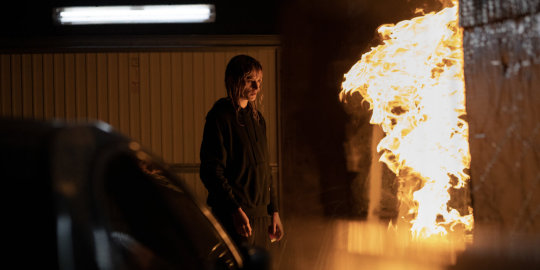
Agathe Rousselle as Alexia, putting her past behind her.
Something that queer people are keenly aware of is the idea of perception, and how perception can often be a threat to people who are pushed aside by society. Could you speak about how that idea of perception played into the way that you wanted to develop the character of Alexia?
It’s absolutely central. The way I look at my film, everything has to do with gaze—with the way you look at someone. A lot of people ask me why I use the body-horror grammar, and why I tear the flesh like this, and that’s why. For me, the flesh and the skin is the first barrier of outside representation, and of outside expectation. We have got to shed it. We have to shed the skins one by one in order to try to be free, and basically to be ourselves—or even moreso, to become ourselves, because I tend to see things always as a becoming more than a state.
The way I tried to portray that in my film is actually with the father figures. Alexia’s biological father is a character who never, ever, ever looks at her. He just dismisses her very existence from the start, which makes her someone who doesn’t have any contours. She does not have a clear identity.
That’s why there is an overflow of impulses getting out of her because there is nothing to contain that. She is completely loose, if you wish.
Then she meets Vincent. Where is his headspace when she comes into his life, and what do they find in one another?
On the contrary to Alexia, Vincent is a very neurotic character. He’s a character inspired by the movie Vertigo, and how Jimmy Stewart’s character completely sculpts his own fantasy onto Kim Novak.
I insisted on Vincent never being this white knight in shining armor. In his overbearing neurosis he also becomes incredibly intrusive. The thing that makes him different from the biological father is that because of his fantasy, he has to look at her constantly. He wants to sculpt that fantasy. He wants to create it.
At this level, he gives her the contours of someone else, but it so happens that at one point she decides that she feels good in these contours, even though they are the wrong ones. They’re not hers, but she feels good. She decides to adopt those contours, which we see the turn happen when she comes back after leaving, and she doesn’t kill him.
That’s where she decides that she feels better in these contours than in the previous ones she had when she was a woman. After that, she begins to get in touch with her humanity through this relationship. She gets in touch with her emotions, which never happened before, and it makes her feel alive. It’s like for the first time in her life she actually starts to exist.
The challenge for her at this level, and the higher stakes, is to actually show herself for who she is to the person that she came to love—and to be accepted as she is. This lasts until the final moment of the film.
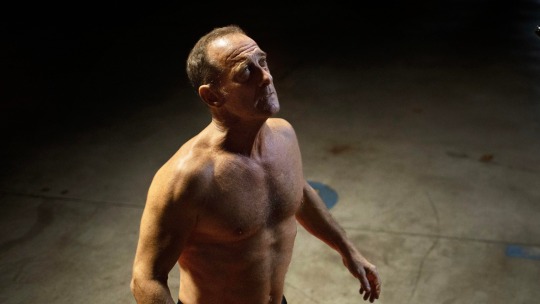
Vincent Lindon, as Vincent, working his body out after hours.
It’s a fascinating arc, as we also see the more she gets in touch with her humanity, the less her body looks human.
This is also something very important in the film in terms of where we stand in our own humanity. That’s why at the end she decides to go to him, and to show herself naked, just the way she is. To tell him, “I love you. The way I am now loves you.” You see how it’s a very long journey through, ending on the idea that gender is irrelevant when it comes to identity.
Speaking of that notion of gender in conjunction with how you explore the use of the body in your films, I have to ask you about the pair of firefighter dancing scenes, both of which have a heavy air of homoeroticism. The first is a lovely sequence bathed in this purple light, and later there’s a more aggressive mosh pit. What ideas did you want to draw out in these sequences?
In that first one, the homoeroticism that’s present there is debunking the kinds of expectations we could have of firefighters together. It’s again trying to soften this idea of sheer testosterone. Actually, if you look closely, some of the firemen in the background are very good dancers. They have some really good moves, which makes it even more artistic. Somehow it becomes more of a tableaux than just a regular party, which is something I was aiming for. That’s why I used real dancers to play the firemen at this moment. The idea of tableaux is essential, especially when you use slo-mo like this.
As you mentioned, there is a clear difference between the two scenes. With the mosh pit, we used this very white shower light to blend every extra and Adrien together so that they all look alike. They all have shaved heads, big muscles, and are jumping around all over the place. At a certain point, you don’t know who’s who anymore. That’s the intention, as Adrien is at the point where she wants to keep Vincent so badly that she would do anything to blend in completely.
However, this desire to blend in or to belong is something that I see as quite violent. This is not a positive to me. Belonging is never a positive in my mind, for the identity or for the psyche. That’s why it’s so physical and so aggressive.
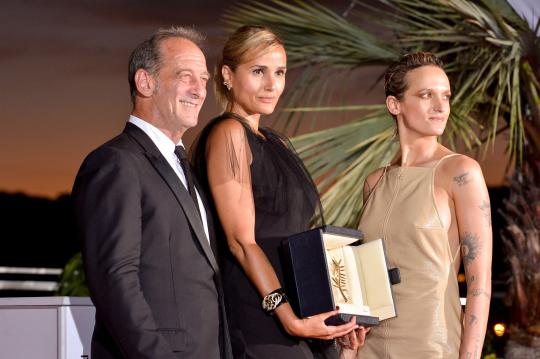
Vincent Lindon, Julia Ducournau and Agathe Rousselle at the 74th Cannes Film Festival. / Photo by Julien Reynaud/APS-Medias
That scene takes a big shift once Alexia gets on top of the truck, and we see her inner self start to come to the surface.
When she’s alone on top of the truck, it’s the exact opposite of what the scene was before—the opposite of that violence. She’s on the truck in the form of this pedestal, if you wish, because I tried to instill something that was very sacred there. The firemen look at her either like she’s a Messiah, or they look away because it’s too much to look at. It’s too bright, it’s too strong.
At this level, this is for me the moment where she has moved past this idea of belonging and blending in. She’s feeling herself with both Adrien and Alexia, and something even more. This is her in that moment. There is full grace in this moment, which is what I was aiming at. You see all the way through the film how dance is something I use to go against the audience’s expectations.
On behalf of all Letterboxd film lovers, I want to thank you for your commitment to art that rips open our hearts and brains like this—and as a genderqueer person, thank you for making a film that made me feel so seen.
That means a lot to me. Thank you very much, Mitchell.
Related content
Gory B Movie’s list of horror films directed by women from 1900—present
Maxvayne’s extensive list of body-horror films
Bionic Tim’s list of New French Extremity & Modern French Horror, ranked
Follow Mitchell on Letterboxd
‘Titane’ is in theaters now and will be available on VOD from Tuesday, October 19.
#titane#julia ducournau#female director#directed by women#french cinema#cinema du femme#agathe rousselle#vincent london#palme d'or#cannes#tiff midnight madness
6 notes
·
View notes
Photo

Noir Zealand Road Trip.
Breakout noir filmmaker James Ashcroft speaks to Letterboxd’s Indigenous editor Leo Koziol about his chilling new movie Coming Home in the Dark—and reveals how Blue Velvet, Straw Dogs and a bunch of cult New Zealand thrillers are all a part of his Life in Film.
“Many different types of feet walk across those lands, and the land in that sense is quite indifferent to who is on it. I like that duality. I like that sense of we’re never as safe as we would like to think.” —James Ashcroft
In his 1995 contribution to the British Film Institute’s Century of Cinema documentary series, Sam Neill described the unique sense of doom and darkness presented in films from Aotearoa New Zealand as the “Cinema of Unease”.
There couldn’t be a more appropriate addition to this canon than Māori filmmaker James Ashcroft’s startling debut Coming Home in the Dark, a brutal, atmospheric thriller about a family outing disrupted by an enigmatic madman who calls himself Mandrake, played in a revelatory performance by Canadian Kiwi actor Daniel Gillies (previously best known for CW vampire show The Originals, and as John Jameson in Spider-Man 2). Award-winning Māori actress Miriama McDowell is also in the small cast—her performance was explicitly singled out by Letterboxd in our Fantasia coverage.
Based on a short story by acclaimed New Zealand writer Owen Marshall, Ashcroft wrote the screenplay alongside longtime collaborator Eli Kent. It was a lean shoot, filmed over twenty days on a budget of just under US $1 million. The film is now in theaters, following its premiere at the Sundance Film Festival in January, where it made something of an impact.

Erik Thomson, Matthias Luafutu, Daniel Gillies and Miriama McDowell in a scene from ‘Coming Home in the Dark’.
Creasy007 described the film as “an exciting New Zealand thriller that grabs you tight and doesn’t let you go until the credits are rolling.” Jacob wrote: “One of the most punishingly brutal—both viscerally and emotionally—first viewings I’ve enjoyed in quite a while. Will probably follow James Ashcroft’s career to the gates of Hell after this one.”
Filmgoers weren’t the only ones impressed: Legendary Entertainment—the gargantuan production outfit behind the Dark Knight trilogy and Godzilla vs. Kong—promptly snapped up Ashcroft to direct their adaptation of Devolution, a high-concept novel by World War Z author Max Brooks about a small town facing a sasquatch invasion after a volcanic eruption. (“I find myself deep in Sasquatch mythology and learning a lot about volcanoes at the moment,” says the director, who is also writing the adaptation with Kent.)
Although Coming Home in the Dark marks his feature debut, Ashcroft has been working in the creative arts for many years as an actor and theater director, having previously run the Māori theater company Taki Rua. As he explains below, his film taps into notions of indigeneity in subtle, non-didactic ways. (Words in the Māori language are explained throughout the interview.)
Kia ora [hello] James. How did you come to be a filmmaker?
James Ashcroft: I’ve always loved film. I worked in video stores from the age thirteen to 21. That’s the only other ‘real job’ I’ve ever had. I trained as an actor, and worked as an actor for a long time. So I had always been playing around with film. My first student allowance that I was given when I went to university, I bought a camera, I didn’t pay for my rent. I bought a little handheld Sony camera. We used to make short films with my flatmates and friends, so I’ve always been dabbling and wanting to move into that.
After being predominantly involved with theater, I sort of reached my ceiling of what I wanted to do there. It was time to make a commitment and move over into pursuing and creating a slate of scripts, and making that first feature step into the industry. My main creative collaborator is Eli Kent, who I’ve been working with for seven years now. We’re on our ninth script, I think.
But Coming Home in the Dark, that was our first feature. It was the fifth script we had written, and that was very much about [it] being the first cab off the rank; about being able to find a work that would fit into the budget level that we could reasonably expect from the New Zealand Film Commission. I also wanted to make sure that piece was showing off my strengths and interests—being a character-focused, actor-focused piece—and something that we could execute within those constraints and still deliver truthfully and authentically to the story that we wanted to tell and showcase the areas of interest that I have as a filmmaker, which have always been genre.
Do you see the film more as a horror or a thriller?
We’ve never purported to be a horror. We think that the scenario is horrific, some of the events that happen are horrific, but this has always been a thriller for me and everyone involved. I think, sometimes, because of the premiere and the space that it was programmed in at Sundance, being in the Midnight section, there’s a sort of an association with horror or zany comedy. For us it’s more about, if anything, the psychological horror aspect of the story.
It’s violent in places, obviously, but there’s very little violence actually committed on screen. It’s the suggestion. The more terrifying thing is what exists in the viewer’s mind [rather] than necessarily what you can show on screen. My job as a storyteller is to provoke something that you can then flesh out and embellish more in your own psyche and emotions. It’s a great space, the psychological thriller, because it can deal with the dramatic as well as some of those more heightened, visceral moments that horror also can touch on.
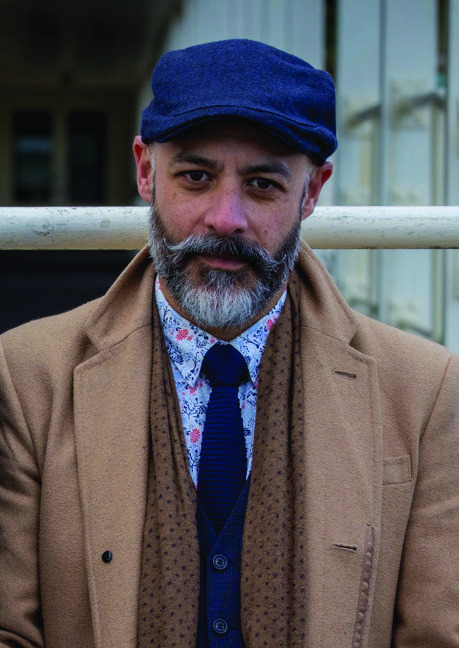
Director James Ashcroft. / Photo by Stan Alley
There’s a strong Māori cast in your film. Do you see yourself as a Māori filmmaker, or a filmmaker who is Maori?
Well, I’m a Māori everything. I’m a father, I’m a husband, I’m a friend. Everything that I do goes back to my DNA and my whakapapa [lineage]. So that’s just how I view my identity and my world. In terms of categorizing it, I don’t put anything in front of who I am as a storyteller. I’m an actor, I’m a director. I follow the stories that sort of haunt me more than anything. They all have something to do with my experience and how I see the world through my identity and my life—past, present and hopefully future.
In terms of the cast, Matthias Luafutu [who plays Mandrake’s sidekick Tubs], he’s Samoan. Miriama McDowell [who plays Jill, the mother of the family] is Māori. I knew that this story, in the way that I wanted to tell it, was always going to feature Māori in some respect. Both the ‘couples’, I suppose you could say—Hoaggie [Erik Thomson] and Jill on one side and Tubs and Mandrake on the other—I knew one of each would be of a [different] culture. So I knew I wanted to mirror that.
Probably more than anything, I knew if I had to choose one role that was going to be played by a Māori actor, it was definitely going to be Jill, because for me, Jill’s the character that really is the emotional core and our conduit to the story. Her relationship with the audience, we have to be with her—a strong middle-class working mother who has a sort of a joy-ness at the beginning of the film and then goes through quite a number of different emotions and realizations as it goes along.
Those are sometimes the roles that Māori actors, I often feel, don’t get a look at usually. That’s normally a different kind of actor that gets those kinds of roles. And then obviously when Miriama McDowell auditions for you it’s just a no-brainer, because she can play absolutely anything and everything. I have a strong relationship with Miriama from drama-school days, so I knew how to work with her on that.
Once you put a stake in the ground with her, then we go, right, so this is a biracial family, and her sons are going to be Māori and that’s where the Paratene brothers, who are brothers in real life, came into the room, and we were really taken with them immediately. We threw out a lot of their scripted dialogue in the end because what we are casting is that fundamental essence and energy that exists between two real brothers that just speaks volumes more than any dialogue that Eli and I could write.

Matthias Luafutu as Tubs in ‘Coming Home in the Dark’.
What was your approach to the locations?
[The area we shot in] is very barren and quite harsh. I spent a lot of time there in my youth, and I find them quite beautiful places. They are very different kinds of landscapes than you normally see in films from our country. We didn’t want to go down The Lord of the Rings route of images from the whenua [land] that are lush mountains and greens and blues, even though that’s what Owen Marshall had written.
I was very keen, along with Matt Henley, our cinematographer, to find that duality in the landscape as well, because the whole story is about that duality in terms of people, in terms of this world, and that grey space. So that’s why we chose to film in those areas.
Regarding the scene where Tubs sprinkles himself with water: including this Māori spiritual element in the film created quite a contrast. That character had partaken in something quite evil, yet still follows a mundane cultural tradition around death. What are your thoughts on that?
Yeah. I’m not really interested in black-and-white characters of any kind. I want to find that grey space that allows them to live within more layers in the audience’s mind. So for me—and having family who have spent time in jail, or knowing people who have gone through systems like state-care institutions as well as moving on to prison—just because you have committed a crime or done something in one aspect of your life, that doesn’t mean that there isn’t room and there aren’t other aspects that inform your identity that you also carry.
It’s something that he’s adopted for whatever reasons to ground him in who he is. And they can sit side by side with being involved in some very horrendous actions, but also from Tubs’ perspective, these are actions which are committed in the name of survival. You start to get a sense Mandrake enjoys what he does rather than doing it for just a means to the end. So any moment that you can start to create a greater sense of duality in a person, I think that means that there’s an inner life to a world, to a character, that’s starting to be revealed. That’s an invitation for an audience to lean into that character.

Erik Thomson and Daniel Gillies in ‘Coming Home in the Dark’.
What is the film that made you want to get into filmmaking?
The biggest influence on me is probably David Lynch’s Blue Velvet. I saw that when I was ten years old. A babysitter, my cousin, rented it. It’s not a film that a ten-year-old should see, by the way. I was in Lower Hutt, there in my aunty’s house, and it was very cold, and there’s a roaring fire going. My cousin and her boyfriend were sitting on a couch behind me, and they started making out. I sort of knew something was going on behind me and not to look. So I was stuck between that and Dennis Hopper huffing nitrous, and this very strange, strange world opening up before me on the television.
I’ve had a few moments like that in my life [where a] film, as well as the circumstance, sort of changed how I view the world. I think something died that day, but obviously something was born. You can see what Lynch did in those early works, especially Blue Velvet. You don’t have to go too far beneath the surface of suburbia or what looks normal and nice and welcoming to find that there’s a complete flip-side. There’s that duality to our world, which we like to think might be far away, but it’s actually closer than you think.
That speaks to Coming Home in the Dark and why that short story resonated with me the first time I read it. Even in the most beautiful, scenically attractive places in our land, many different types of feet walk across those lands, and the land in that sense is quite indifferent to who is on it. I like that duality. I like that sense of we’re never as safe as we would like to think. Blue Velvet holds a special place in my heart.
What other films did you have in mind when forming your approach to Coming Home in the Dark?
Straw Dogs, the Peckinpah film. The original. Just because it plays in that grey space. Obviously times have changed, and you read the film in different ways now as you might have when it first came out. But that was a big influence because there was a moral ambiguity to that film; those lines of good and bad or black and white, they don’t apply anymore. It just becomes about what happens when people are put under extreme pressure and duress, and they abandon all sense of morals. The Offence by Sidney Lumet would be another one, very much drawn to that ’70s ilk of American and English filmmaking.
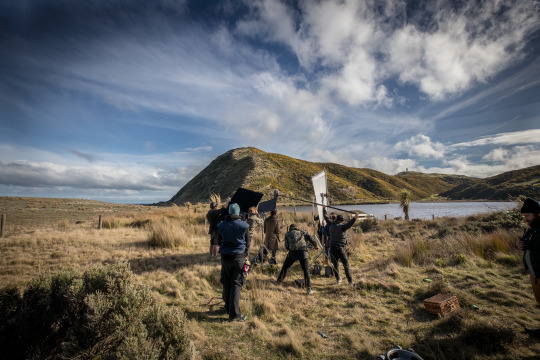
‘Coming Home in the Dark’ was filmed on location around the wider Wellington region of New Zealand.
Is there a New Zealand film that’s influenced you significantly?
There’s a few. I remember watching The Lost Tribe when it was on TV. That really scared me. I just remember the sounds of it. Mr. Wrong was a great ghost story. That stuck with me for a long time. The Scarecrow. Once I discovered Patu! [Merata Mita’s landmark documentary about the protests against the apartheid-era South African rugby tour of New Zealand in 1981], that sort of blew everything out of the water, because that was actually my first induction and education that this was something that even occurred. I think I saw that when I was about eighteen. That this was something that occurred in our history and had ramifications that were other than just a rugby game.
And Utu, every time I watch that, it doesn’t lose its resonance. I get something new from it every time. It’s a great amalgamation of identity, culture, of genre, and again, plays in that grey space of accountability. Utu still has that power for me. It’s one of those films, when it’s playing, I’ll end up sitting down and just being glued to the screen.
It’s a timeless classic. I will admit that when I watched your film, The Scarecrow did immediately come to mind, as did Garth Maxwell’s Jack Be Nimble.
Yeah. [Jack Be Nimble] was really frightening. Again, it was that clash of many different aspects. There was a psychosexual drama there. You’ve got this telekinetic mind control and that abuse and that hunkering down of an isolated family. There are plenty of New Zealand films that have explored a sort of similar territory. They’re all coming to me now.
Bad Blood has a great sense of atmosphere and photography and the use of soundscape to create that shocking sense of isolation and terror in these quick, fast, brutal moments, which then just sort of are left to ring in the air. But I love so much of New Zealand cinema, especially the stuff from the ’80s.
Kia ora [good luck], James.
Kia ora.
Related content
Leo’s Letterboxd list of Aotearoa New Zealand Scary-As Movies Adapted from Literature
Dave’s Cinema of Unease list
A Brutal Stillness: Gregory’s list of patient, meditative genre films
Sailordanae’s list of Indigenous directors of the Americas
Follow Leo on Letterboxd
‘Coming Home in the Dark’ is available now in select US theaters and on VOD in the US and New Zealand. All photographs by Stan Alley / GoldFish Creative. Comments have been edited for length and clarity.
#coming home in the dark#letterboxd#daniel gillies#james ashcroft#maori culture#maori movie#maori director#native director#indigenous film#miriama mcdowell#noir#new zealand noir#leo koziol#imagiNATIVE
3 notes
·
View notes
Photo
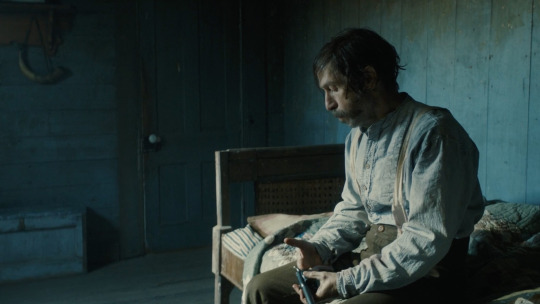
Work Horse.
Taking on a rare leading role in his decades-spanning career, national treasure Tim Blake Nelson speaks with Mitchell Beaupre about demystifying heroes, reinventing genres and something called a quiche Western.
“This film is unapologetic about all the tropes that it’s deploying in service of telling the story... You’ve got a satchel full of cash. You’ve got gunslinging, physical violence, and feeding somebody to the pigs.” —Tim Blake Nelson
Described by Letterboxd members as “a national treasure” who “makes everything better”, Tim Blake Nelson is a journeyman actor who has tapped into practically every side of the industry since making his feature debut in Nora Ephron’s This Is My Life back in 1992. Whether you are a Marvel fanatic, a history buff or a parent trying to get through the day, the actor’s distinctive presence is a charming sight that’s always welcome on the screen.
Tim Blake Nelson is one of those rare actors who unites all filmgoers, a man genuinely impossible not to love, which certainly seems to be the case for Hollywood. Checking off working relationships with directors ranging from Terrence Malick and Ang Lee to Hal Hartley and Guillermo Del Toro, Nelson has covered the boards, even crossing over into directing and writing, both in films and on the stage.
Yet, despite being a renowned talent who can take a smaller supporting role in a massive Steven Spielberg blockbuster starring Tom Cruise and carry the film, Nelson-as-leading-man sightings have been few and far between. In fact, it’s quite a struggle to find a film with Nelson in a leading role, as even playing the titular role for directors who understand his greatness still results in him only appearing in the opening section of an anthology feature.

At last, the leading role Nelson fans were in need of has arrived in the form of Old Henry, a new Western from writer/director Potsy Ponciroli. Nelson plays the eponymous Henry, a widowed farmer with a mysterious past who makes a meager living with his son (Gavin Lewis), doing his best to leave his old life behind and hide away from the world. Things get complicated when Henry stumbles upon a satchel of cash and a wounded stranger (Scott Haze), bringing them both into his home. Soon, a dangerous posse led by an intimidating Stephen Dorff comes calling, setting the stage for an old-fashioned throwdown in this twisty Western siege thriller.
Premiering at the Venice Film Festival, Old Henry has been warmly received on Letterboxd. “Old Henry feels like the culmination of Tim Blake Nelson’s twenty-plus-year career, but from another dimension, where he’s highly regarded as a leading man”, writes Noah, speaking not only to the strength of Nelson’s performance, but also to the fact that this leading role shouldn’t be such a rarity. Todd awards Nelson the prize for “Best Facial Hair in a 2021 film”, before applauding the actor for pouring “every emotion in his body to play Henry”.
Letterboxd’s East Coast editor Mitchell Beaupre saddled up for a chat with Nelson about the intentional hokiness of the Westerns that made him fall in love with filmmaking, how the Coen brothers put other directors on notice, and the fatherly joy of keeping it all in the family.
I’ve seen a lot of interviews with you discussing your career as an actor, a writer, and a director. You always speak with such reverence for the art. Where does that passion come from for you? What made you want to pursue this field?
Tim Blake Nelson: It’s funny, doing these interviews for Old Henry has been reminding me of my introduction to filmmaking as an art. I’ve realized that I had never quite located it, but it really started with the Sergio Leone Westerns, which I would see on television when I was growing up in Oklahoma in the ’70s. Before that, going to the cinema was always invariably a treat, no matter what the film, but I would just be following the story and the dialogue.
The Sergio Leone movies were the first ones that exposed subjectivity in telling stories on film to me. That was where I became aware of the difference between a closeup and an extreme closeup, or how you could build tension through a combination of the angle on a character with the editorial rhythm, with the lens size, with the music in addition to the dialogue and the story.
How old were you when this shift in your understanding of cinema was happening?
I think it was across the ages of ten and eighteen, where I suddenly realized that this was an auteur here, Leone. There was a guy behind all these movies I was seeing—and in Oklahoma, you could see a Sergio Leone movie every weekend. This was a man making deliberate and intelligent decisions in everything that I was seeing.
I started noticing that a character was in a duster that goes all the way down to his boots, even though that’s not necessarily accurate to the Old West. That’s something else. Also, why is he wearing it in the desert? Would that have been very practical? And look at that cigar Clint Eastwood is smoking. It’s not smooth, it looks like it was a piece of tree root. Then later I learned it’s a particular kind of Italian cigar, but somehow it was defining this genre of Western. I marveled at that, and found it unbelievably thrilling to discover. I loved the stories and the dialogue and the intentional hokiness of it all. All of it was conspiring to teach me to venerate this form.
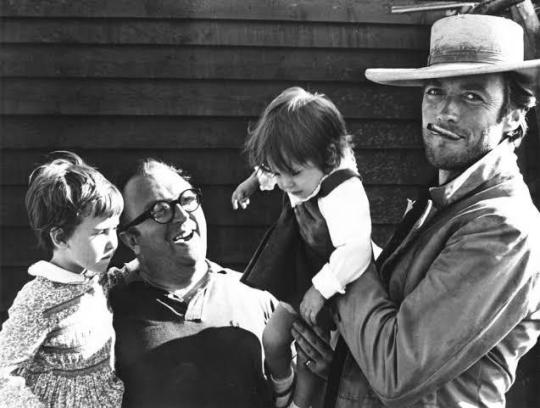
Sergio Leone, his daughters, and Clint Eastwood on the set of ‘The Good, the Bad and the Ugly’ (1966).
The connection there is interesting between the Leone Westerns to where Old Henry is at now. You’ve talked before about how the Western genre is one that is reinvented over and over throughout the years—
Oh, you do your homework!
I try my best! What would you say defines the current era of Westerns that we’re seeing, and how the genre is being reinvented?
Well, Joel and Ethan [Coen] did a lot of mischief, in a good way, with The Ballad of Buster Scruggs. Genres are always about genres, in addition to their story. So, I would say that Buster Scruggs is the quintessential postmodern Western, if you look at it as one movie instead of as an anthology, because it celebrates the history of the form. The magic of that movie is that it engages you in each story while also being a meditation on death. That’s what connects each one of those tales, and then it’s also a meditation on storytelling to boot. In the final chapter, you have a character talking about why we love stories, and he’s telling it to a bunch of people who you’ll learn are all dead.
The stories are a way of delaying the inevitable mortality.
I mean, look at that. It’s such an accomplishment. With that movie, I think Joel and Ethan put filmmakers on notice that Westerns had better always be also about Westerns, because whether you like it or not, they are. I think they probably came to understand that when they were making True Grit, although knowing the two of them they probably understood it already.
Do you feel there’s a direct correlation between a movie like Buster Scruggs and Old Henry, in this era of postmodern, revisionist Westerns?
How it impacts a movie like Old Henry is that you have Potsy embracing the Western-ness of the movie. This film is unapologetic about all the tropes that it’s deploying in service of telling the story. You’ve got the cantankerous old man hiding a past, who’s a maverick who wants to keep the law and the bad guys off his property. He wants to be left alone. You’ve got a satchel full of cash. You’ve got gunslinging, physical violence, and feeding somebody to the pigs. Yet, it’s all accomplished without irony in a very straightforward way that is utterly confident, and in love with the genre.
I think ultimately that’s why the movie works, because it’s very front-footed. It’s not hiding from you. It’s not deceiving you and trying to tell you it’s something that it isn’t. It’s a good, straightforward Western.

Tim Blake Nelson as the titular singer in ‘The Ballad of Buster Scruggs’ (2018).
That’s a bit different from those Leone Westerns, with all of their anachronisms.
I remember when the movie Silverado came out when I was growing up, and people were calling it a “quiche Western”, which was funny. That was what they would call it in Oklahoma because it had a bunch of movie stars in it, who weren’t known for being in Westerns. It was the Sergio Leone crowd calling it that. I went and saw it, wondering, “Well, if it’s a quiche Western, then why is everybody talking about it?” I saw it, and I loved it. Those folks putting it down like that were wrong. It’s actually a straightforward, hard-boiled, hardcore unapologetic Western. You don’t like some of the movie stars in it, but get over it. The reason that movie works is because it’s straight-ahead and well-told, and I think that movie holds up.
Old Henry is the same kind of animal. It’s more in the tradition of Sergio Leone—or, actually, I would say more in the tradition of Unforgiven. That was a big influence on Potsy.
Unforgiven was marvelous in the way it demystified that old black hat/white hat mentality of Westerns, opening up a more multi-dimensional understanding. You’re no stranger to that. A series like Watchmen takes that approach with superheroes, who in a sense hold the position now that Western heroes used to hold culturally. Do you find there’s more of a demand these days to challenge those archetypes who used to be put on pedestals—be they superheroes, cowboys, police—and provide a deeper analysis?
Absolutely, yes. At the same time, I think the demystified Western hero goes back to John Wayne in The Searchers. I think it really started with that character, one of the greatest characters ever in a Western. There’s One-Eyed Jacks, with Marlon Brando, which was made just after The Searchers, and again embracing this concept of an extremely complicated man. I don’t think you get the Sergio Leone movies without that.
I always think of McCabe & Mrs. Miller as a Western that was doing something totally different than anything I had seen before.
That’s another one, with that final image with the character smoking opium, going into oblivion after the demise of Warren Beatty’s very flawed character, after you’ve watched what it has taken to really build that town. You have a director, Robert Altman, making the deliberate choice to shoot in order so that they can build the town while they’re shooting the movie, and you really get the cost of it. I think there’s a lot of history to get to a place where a movie like Unforgiven can happen. Then Clint comes along and, as he often does, moves it forward even more.

Gavin Lewis as Henry’s son Wyatt in ‘Old Henry’.
That’s a film that tackles legacy, as does Old Henry, which at its core is ultimately about the relationship between a father and his son. You got to work on this film with your own son, coincidentally named Henry, who was part of the art department. What is that experience like, getting to share your passion with your son on a project together?
Well, I think something that is true for the character of Henry and for myself, and perhaps all of us, is that we all want our kids to have better lives than ours. I want that to be true in every respect. Mostly, I want them to be more fulfilled than I have been. My kids look at me when I say that and say, “Thanks a lot Dad for raising that bar”, because they see that I have a pretty good life. Which I do, but I still think they can be more fulfilled than I am, and I want that for them. One of the great privileges of this movie was to watch my son—who was the on-set decorator—work his ass off.
Those are the words of an incredibly proud father.
He’s a work horse, and he’s learning about filmmaking, and I think on his current trajectory he will go beyond where I’ve gone as a filmmaker, directing more movies than I’ve been able to direct. Do a better job at it, too. He’s also a singer-songwriter, and I think he can have a venerable career doing that if he wants, but he wants to make movies too, and I hope that’s going to happen for him. It was a thrill to watch him do the work, the twelve- and fourteen-hour days, and after every take resetting and making sure everything was right. It felt like an accomplishment to see him take on that responsibility and do the real work every day.
Related content
SJ Holiday’s lists of Essential Neo-Westerns and Essential Modern Westerns
The Best Neo-Westerns of the 21st Century, according to JS Lewis
Our interview with Slow West director John Maclean
Follow Mitchell on Letterboxd
‘Old Henry’ is in US theaters now and on VOD from Friday, October 8.
#tim blake nelson#old henry#western#westerns#western movies#sergio leone#clint eastwood#stephen dorff#letterboxd#mitchell beaupre#coen brothers#coen bros#buster scruggs#joel coen#ethan coen
19 notes
·
View notes
Photo
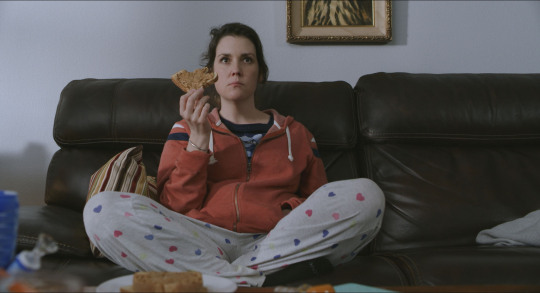
Slovenly Creatures.
A Life in Film chat with Letterboxd fave Melanie Lynskey about fart jokes, comfort comedies, foundational film idols and her obsession with Kevin Hart.
“Not all the plot points have to tie together, it doesn’t have to make sense, it doesn’t have to be perfectly sharp. It just has to be funny, that’s all.” —Melanie Lynskey
Search through Letterboxd and you’ll find that New Zealand-born Melanie Lynskey has a special place in the hearts of film lovers. Lists dedicated to “my favorite actress”, “the least-appreciated currently working character actress”, “lovely Melanie Lynskey films”. Reviews that consist mainly of Melanie Lynskey’s name, over and over again. And so it is with her latest film, Lady of the Manor. Reviews of the ghostly, farty buddy-comedy are united on one thing: Melanie Lynskey.
Her secret involves a smart straddling of the indie-mainstream fence, one foot in comedy, the other in drama, and a weathered eye on the politics of her industry. Follow her Twitter account, and you’ll see that Lynskey’s tastes and influences are wide-ranging. She is a hungry devourer of recaps, a staunch ally of the marginalized, and generous with her praise of great work (including those she works with).
But for Letterboxd fans, it is simply about what Lynskey herself brings to every role, whether that be character parts in cult camp like But I’m a Cheerleader and Coyote Ugly, or as a devoted participant in 21st-century indie fare, often involving the Duplass brothers, and often with long, existential titles, or as a rock-solid addition to A-list ensemble adventures such as Up in the Air, The Informant! and Mrs. America.
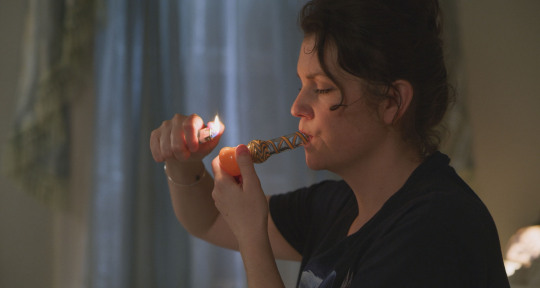
Melanie Lynskey sparks up in ‘Lady of the Manor’.
“I have said it before and I will keep saying it until I lose my figurative online voice,” writes Lynskey stan Fred, “Melanie Lynskey is one of the best working actors and Hollywood needs to catch up yesterday.” She has been serving lesbians since her 1994 break-out in Peter Jackson’s Heavenly Creatures. She is the Queen of Indie. She is a gift. She can do no wrong. She is our spirit animal.
For Lynsksessives, a new Melanie Lynskey season is upon us. A Showtime series, Yellowjackets, in November. In December, she will be seen in Adam McKay’s starry new astronomy caper, Don’t Look Up. And right now, those hunting for a charming indie comedy led by our favorite goofball need look no further than Lady of the Manor, from brothers Justin and Christian Long.
“I wanted ghost Judy Greer interacting with stoner Melanie Lynskey and I got ghost Judy Greer interacting with stoner Melanie Lynskey,” writes Owen, of the supernatural buddy comedy in which hot mess Hannah (Lynskey) is haunted by prim and proper (and probably murdered) Lady Wadsworth (Greer), while trying to hold down a job as a tour guide at Wadsworth Manor.
In order to help Greer’s uptight apparition find peace, Hannah must solve the mystery of the manor’s ownership. That, however, requires her to overcome an extreme lack of ambition, terrible personal hygiene, and sleazy advances from a toxic and horny Ryan Philippe. Angela Alise and Luis Guzmán pop up in somewhat underwritten supporting roles, but Lady of the Manor is, above all, a buffet of physical comedy delights for Lynskey lovers.
Letterboxd editor-in-chief Gemma Gracewood jumped on the line with Lynskey for a laugh and a cry about David Lynch movies, the late Katrin Cartlidge, teen obsessions, and being a responsible Academy voter.
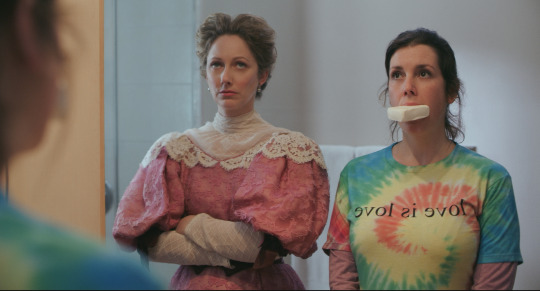
Lady Wadsworth (Judy Greer) serves some manners to her re-enacting dopplegänger, Hannah (Melanie Lynskey).
Lady of the Manor feels like a Pygmalion situation, you know? My Fair Lady, but you are Eliza Doolittle and Judy Greer is Professor Henry Higgins, and the transformation is actually not that huge: Hannah goes from this complete stoner to still a complete stoner, but maybe with a few additional life goals.
Melanie Lynskey: That was the thing that really sold me on the movie, honestly, was that she just didn’t really change that much. The moment that I was, like, ‘I’m going to do this movie’ was when she’s all inspired—“I’m going to return the house to its rightful owner”—and she marches off purposefully, and then it cuts to her at the bar and she’s just wasted again. It was so funny to me. ‘Oh wow, they’re really letting her be a mess. They’re not trying to redeem this person.’
You and Judy Greer have an insane chemistry. Can you share some insights into that working partnership?
It was so much fun. We’ve never gotten to work together, because it’s always: she’s doing the role, or I’m doing the role, or Kathryn Hahn is doing the role. There’s usually one part that’s right for us in a movie, and so, to have two different roles that are right for both of us, it was such a dream.
A lot of it is on the page, because Justin and Christian worked so hard on the script, and it was at a point that they were really, really happy with it, and they were very fond of a lot of the jokes. We did get to add little things here and there. We got a lot of freedom and a lot of room to improv.
Who is the best movie ghost, apart from Judy Greer?
All I can think of is Ghost. Oh, Beetlejuice. There you go. That’s an amazing ghost, that’s a great movie.
What else should we watch Judy Greer in?
Who can name only one favorite Judy Greer performance?! She’s so incredible! The ones that come to mind are Adaptation, The TV Set, Jeff Who Lives At Home and Three Kings. She is a marvel—beautiful, funny, kind, smart, an amazing improviser and a great friend.
What is the film that first made you aware that filmmaking is something you could do, as opposed to watch?
I don’t really know what film made me aware of what filmmaking was! I always knew I wanted to be an actor, since I was about six years old and did a school play. I didn’t really watch a ton of movies as a kid. My parents were not really movie-goers. When I was about thirteen I started watching Twin Peaks, and from there I saw Blue Velvet and Wild At Heart, and that was the beginning of me realizing what kind of work really excited and interested me. So for 30 years now, I’ve had a dream of working with David Lynch.
And I started to try to watch everything that certain actors did. I got very obsessed with Katrin Cartlidge, who became my favorite actor. I loved her in Mike Leigh’s Naked and Career Girls, in Lars Von Trier’s Breaking The Waves, Lodge Kerrigan’s Claire Dolan and Milcho Manchevski’s Before The Rain. Through following Katrin’s career I started to piece together what I wanted my own to look like. She made incredible choices and was just so different and so good in every performance.
I was lucky enough to work with her before she passed; we did a movie of The Cherry Orchard and worked together for three months. I will cherish those memories forever. She was maybe an even more amazing person than she was an actor, and that is really saying something.

A publicity still from ‘The Three Musketeers’ (1993) with Oliver Platt, rear left, as Porthos.
What was the first film that gave you teenage feelings?
Well, I was a bit of a goth as a teenager. When I saw Alison Maclean’s short film Kitchen Sink, that was a big moment for me. I was like, wow. If I could make a movie that would express my soul at this moment, it would be this film. And I have loved all her movies since that one. The Rehearsal was so good! And Jesus’ Son. I keep hoping I’ll get to work with her.
As a teen I was very swoony over Oliver Platt. He was my number one crush. So any Oliver Platt film had me feeling some things—Flatliners and The Three Musketeers, especially. I’m still swoony over him today, to be honest.
What is the next hidden gem that you think Letterboxd members should watch?
My two favorite movies in recent memory are Shannon Murphy’s Babyteeth and Remi Weekes’ His House. Eliza Scanlen is absolutely glorious in the former. It’s a really deep and beautiful performance. Her parents are played by the incomparable Ben Mendelsohn and Essie Davis, both of whom destroyed me. The whole movie destroyed me. But my favorite performance in the movie comes from Toby Wallace, as the young-but-older love interest of Eliza Scanlen’s character. My god, this is an electric performance. He’s unbelievably good in it. Emily Barclay is great in it too. The movie is funny, heartbreaking and beautifully directed. The music is amazing.
And His House is just great. A really creepy, twisty thriller with a very tragic story at its center. It’s about a refugee couple who have escaped from South Sudan and are moved into housing in England, and the house is torturing them. It’s the most compelling movie I’ve seen in such a long time. The two leads, Wunmi Mosaku and Sope Dirisu, are flat out movie stars. You can’t take your eyes off either of them and the performances resonate on a thousand different levels. They’re astounding, and it’s incredibly accomplished filmmaking. Please please see these movies.
Because you’re from New Zealand, we’d be remiss not to ask what’s a must-see New Zealand film in your opinion?
If we’re talking about silly, fun comedies, and also women being funny and silly, I really love The Breaker Upperers. That was very, very, very charming and hilarious to me. I hope that more people see that.
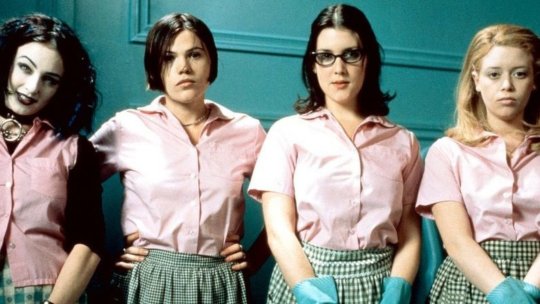
Katharine Towne, Clea DuVall, Melanie Lynskey and Natasha Lyonne in ‘But I’m a Cheerleader’ (2000).
For anyone still sleeping on Letterboxd favorite But I’m a Cheerleader, in one sentence, why should they watch it?
Oh, because it’s a campy romance with an amazing cast. It’s Clea DuVall and Natasha Lyonne falling in love with each other, it’s sexy, it’s sweet, it’s genuinely funny. It’s beautiful to look at. That’s not one sentence, that’s about twelve sentences, sorry. I’m so proud of that movie, I love that movie so much.
It’s an interesting one. It’s been growing in stature around here over the years, and I love to see it.
Yeah, very much. The reviews were outright negative when it came out.
What was the last film that made you cry, either because it was so sad, or because you were cry-laughing, or any definition of tears being shed?
Mm, gosh, the last film that made me cry… Oh, do you know what? I really cried at the end of Another Round, where he’s dancing.
That ending.
I’m going to cry. Sorry, it really got me. And also knowing what Thomas Vinterberg had been through, just the joy that was in that moment, the idea that you can just go through all this, and still have these moments of joy, and return to this person that you were before all this life happened to you. Just the purity of that moment really, really got me.
And not to mention just the sheer joy of Mads Mikkelsen dancing.
Yeah, god, just the beauty of that man in that moment and, ugh, god, what a great movie.
What mindfuck movie changed you for life?
It would probably be La Cérémonie. I had kind of a one-two punch of being introduced to Isabelle Huppert with La Cérémonie and Amateur, and it’s been true love ever since. I was like, who is this and what else can I see her in immediately??
I don’t know if La Cérémonie is a mindfuck but it’s definitely very dark and it gets really crazy! Sandrine Bonnaire is amazing in it too. But the first time I got to see the incredible intensity and commitment of Isabelle Huppert is really a moment I’ll never forget. It feels like there is a before and after for me.
Finally, some Letterboxd members have described the joy Lady of the Manor has brought them in the midst of an ongoing pandemic. As Robert writes, “I’ll watch Melanie and Judy ham it up for an hour and a half, and be fine with that. Some of the lame jokes in this have made me laugh harder than most films I’ve seen this year.” When it comes to the role of comedy in a crisis, what are the cozy, comfort re-watches that have kept you going through the pandemic?
Aw. I have a toddler, so we’re not watching too many movies. Around the time of the Academy Awards, I really buckled down, because I wanted to be a responsible voter, and I tried to watch everything. So, that was the most movies that I’ve done in a concentrated period of time, but none of that was really “comfort” feeling.
The movies that I do return to, when I feel like I have time to just chill out: Wet Hot American Summer is a big comedy movie for me. Justin did this really weird movie called Strange Wilderness with Steve Zahn and Jonah Hill years ago that is so weird and funny, I really love that one. All the Christopher Guests, like Waiting for Guffman, Best in Show, those are my go to.
And then Kevin Hart. I’m a big, big, big Kevin Hart fan. There are times I’ll be on a plane and I’ll think, “Oh, I should really watch this movie that I’ve been meaning to watch.” But if there’s a Kevin Hart movie, no chance, that’s what I’m going to watch. I’ll go to the movie theater opening weekend to see a Kevin Hart movie. Kevin Hart right now is making a movie with Regina Hall. I’ve seen it on their Instagrams, and I’ve never been more excited for a film.
What is it about Kevin Hart for you?
He is a comedic genius. He is absolutely brilliant, and he will do something in almost every scene that surprises me, and it’s crazy. He can be doing something that’s a real rote, by-the-numbers movie—they’re not all masterpieces—but he makes it new, and interesting, and surprising. Nobody reacts better than Kevin Hart, he is such a funny reactor. He’s always in the moment, I think he makes other people funnier and better. I’m obsessed, I love him.
It’s reassuring to hear you say “they’re not all masterpieces”, because I think comedy is so hard. It is so hard to reach for a five-star comedy, but the truth is that we’re all happy in a sort of three-star comedy world. Those are the films we return to again and again.
Of course! Yeah, and that’s all you’re hoping for with, especially, a silly comedy. You just hope that there’s enough moments that people laugh, and feel like they’ve got a good laugh, and they’ve relaxed for a while. Not all the plot points have to tie together, it doesn’t have to make sense, it doesn’t have to be perfectly sharp. It just has to be funny, that’s all.

Lynskey, as Hannah, with ‘Lady of the Manor’ director and co-writer Justin Long as Max, her academic love interest.
On that note, the Long brothers call this “a fartwarming comedy”, and several Letterboxd reviews comment on Lady of the Manor having “the single best fart joke in ages” or “just the right amount of fart jokes”. Why are farts so funny, Melanie Lynskey?
Do you know what? I don’t find them funny at all, I really don’t. I’m a little bit prissy and there are things in this movie where I was like, “You’re just going to have to tell me exactly what to do.” Like the farting in the room, and burps and stuff like that, I’m not good at that stuff, but people think it’s funny. I don’t know. It’s kind of beyond me…
Wow, so you really exercised your acting muscles on this.
Exactly, exactly, it’s the greatest performance of my life!
Related content
Eileen’s list of gay ’90s movies starring Melanie Lynskey
Mystery Thriller’s list of stoner comedy films
Horny Ghosts—a list by Carlos vs. the Wolf Man
Antoniaaa’s list of female buddy movies
Rent Alison Maclean’s Kitchen Sink and The Rehearsal
Follow Gemma on Letterboxd
‘Lady of the Manor’ is available now on VOD, Blu-ray and DVD. ‘Don’t Look Up’ is in select theaters from December 10, and on Netflix on Christmas Eve.
#melanie lynskey#justin long#judy greer#lady of the manor#comedy#buddy comedy#buddy movie#female buddy movie#adam mackay#steven soderbergh#yellowjackets#don't look up#heavenly creatures#peter jackson#letterboxd
22 notes
·
View notes
Photo

Balls to the Wall.
With his latest film Prisoners of the Ghostland now in theaters and on VOD, one-of-a-kind filmmaker Sion Sono speaks with Mitchell Beaupre about working with Nicolas Cage, fusing Eastern and Western influences, and drawing from Japanese history for his madcap new creation.
“There was a parity in this film when mashing up those East meets West elements. I wanted to take those unique areas and push them together into one box.” —Sion Sono
Working as a filmmaker since the 1980s, Sion Sono has earned a reputation for being one of the most madcap inventors in the game. His highest-rated film on Letterboxd, 2008’s four-hour-long Love Exposure, currently sits in our Official Top 250 Narrative Feature Films, and is described by Ayush as “an ambitious, outrageously sprawling epic about love, lust, religion, cults, adolescent angst, identity, family, friendship, lies, boners, neglect, rebellion, trauma, and the art of up-skirt photography”.
This gives you an idea of what you may expect to see in a Sion Sono creation, although ultimately nothing can fully prepare you for the things which inhabit his mind. You simply have to see them for yourself.
After more than three decades of prolifically delivering his energetic oddities, occasionally even having multiple films released in the same year, 2021’s Prisoners of the Ghostland marks the first time the Japanese director has made a film in the English language. This isn’t for lack of trying. Sono-san was originally set to helm Lords of Chaos back in 2009 until that production eventually went in a different direction.

Ghostland came with its own complications, to put it mildly. First announced in December 2018, Nicolas Cage was set to star, with Sono-san intending to shoot the film in Mexico. In February 2019, shortly after Imogen Poots was cast alongside Cage, the director suffered a heart attack, requiring emergency surgery and putting pre-production on halt and the film in jeopardy. Thankfully, he recovered, but was no longer able to shoot outside of Japan, causing a further shift in plans.
In a way, shooting his first English-language project in Japan feels appropriate for the film, with its culture-clashing identity drawing influence from Spaghetti Westerns, samurai films, and so much more. Like the Ghostland depicted in the film, Prisoners of the Ghostland exists somewhere outside of time and location, creating a piece entirely of its own identity.
Premiering in January 2021 at the Sundance Film Festival, Prisoners of the Ghostland earned divisive reviews, not entirely unsurprising for a filmmaker as bold as Sono-san tends to be. While the story was found to be lacking for some, others described it as being “made from the combined love of different cultures, mythology and cinema, but maybe most importantly the love of art in sets, props and practical effects”.
Cage plays the film’s protagonist, appropriately named Hero, who is serving time in Samurai Town for a bank robbery gone wrong. Hero is released thanks to a nefarious villain known as The Governor (Bill Moseley), who hires him to find and rescue his missing granddaughter (Sofia Boutella, replacing Poots) in exchange for his freedom. The journey—Hero’s Journey, if you will—takes Cage into a post-apocalyptic wasteland that features one of the most elaborate sets of Sono’s career.
With producer Ko Mori translating, Sion Sono sat down with Mitchell Beaupre to discuss making his first English-language project, using the costumes and sets to bring vivid color to the film, and his favorite Nicolas Cage movie.
You had been wanting to make your English-language debut for a while now, originally having it set to be Lords of Chaos, over a decade ago. Was there something pulling you towards making a film in English?
Sion Sono: I feel that the American audience, and European audience, seem to like my films more than the Japanese audience. Thinking about this gave me the idea that maybe I should just go ahead and start shooting in English, so that the film is already for those audiences.
In Prisoners of the Ghostland you draw from an array of cinematic influences, from Spaghetti Westerns to samurai films to post-apocalyptic wastelands. Was it exciting to take these different areas and fuse them together into something totally unique?
There was a parity in this film when mashing up those East-meets-West elements. I wanted to take those unique areas and push them together into one box. The result was creating something in between those two worlds, and thus it became completely original, which was an idea I really liked to explore.
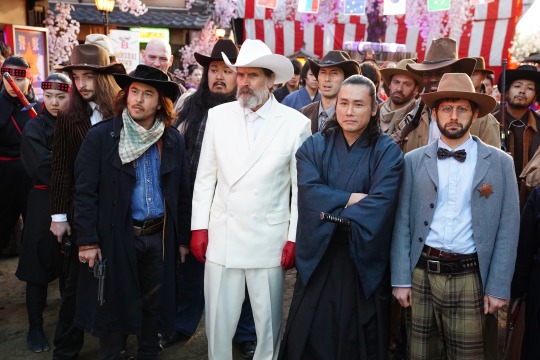
Bill Moseley (in white) as The Governor and Tak Sakaguchi (with sword) as Yasujiro.
In terms of cinematic touchstones, one thing I found particularly interesting was the costuming choices. We see Nicolas Cage’s protagonist dressed in all-black leather, whereas Bill Moseley’s villain is wearing a nice, clean white suit with these striking red gloves. Was there an intentional subversiveness there?
That’s a great question. At the end of the day, the story of the film is quite simple. Because of that, I wanted to make a difference in terms of the details. Part of those details became using the costumes in a unique way. For instance, the film has samurai costumes, but also Western cowboy costumes. I had specific ideas for using bright, vivid colors so that it makes the film stand out visually. As you mentioned, that can be seen in The Governor and his clean white suit which really contrasts with the rest of the color palette in the film.
Another striking element of the film is the Ghostland itself, which is such a massive, complicated set. What was the process of putting that location together?
Along with wanting to use the costume design to make the film stand out when the story is rather simple, I was motivated to do the same thing with the production design. The Ghostland set took a tremendous amount of effort. I didn’t want to use any CGI for it. I would much rather make it all happen in a physical way. That became very difficult to figure out with all of the sets, including the Ghostland. I just wanted to make something super interesting.
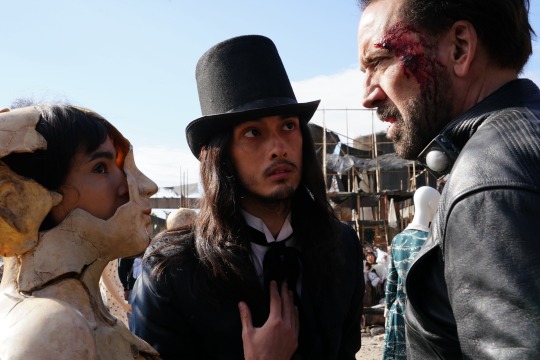
Sofia Boutella as Bernice, Jai West as Jay and Nicolas Cage as Hero.
You’ve mentioned how you incorporated Japanese history, such as the nuclear events in Fukushima and Hiroshima, into the fabric of the film and the construction of the Ghostland set. Could you tell me more about that?
There was a little bit of that element already in the original script. I was able to draw that out, to make it clearer and convey a larger idea regarding atomic energy. Since we were shooting in Japan, the idea of that became even more prevalent in my mind, when thinking about things like Hiroshima and Fukushima.
A great example of this is when you see the clocktower in the Ghostland, and the Ghostlanders are trying to keep the time, or the clock, from moving. They’re trying to hold onto time. The clock is set one minute before 8:15, which is the time that the atomic bomb was dropped on Hiroshima. In the Ghostland, the time is 8:14, and they are trying to stop it from moving because they think once it hits 8:15, then the explosion will happen.
I’d love to talk about Nicolas Cage for a bit. He’s an actor who at this point has an otherworldly, almost supernatural mythos to him. What was your experience like getting to know him, both as an actor, and as a human being?
When Nic Cage and I first met, he had already seen some of my films. Once he came on board the project, though, he went off and watched almost every single one of my films, to have a better understanding of me as a filmmaker. Before we shot the film, Nic went to Hiroshima in order to do some research for himself to try [to] understand the history of Japan. He did so much of his own research, including talking to many people to educate himself further on Japan, and on Japanese culture. That’s the kind of man Nic Cage is.
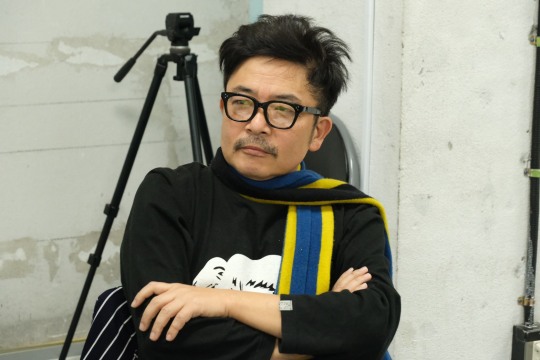
Sion Sono behind the scenes of ‘Prisoners of the Ghostland’.
Did Nic mention if he has a favorite film of yours?
Yes, his favorite film of mine is called Antiporno.
I just saw that for the first time this year and it blew me away.
Thank you very much.
Do you have a favorite Nicolas Cage film?
There are so many that I like, or love, but I would probably say Leaving Las Vegas is the one that is my favorite.
To wrap up, I’d love to know what film was the one which first made you realize you wanted to become a filmmaker?
There were a lot growing up, but when I was young I saw Steven Spielberg’s Jaws, and that was the film which really made me think that maybe I should be a filmmaker.
Related content
Hibiscus’ list of Japanese films that will blow your mind and make you reevaluate the possibilities of the cinematic artform
Darren’s list of high-art genre movies
Follow Mitchell on Letterboxd
‘Prisoners of the Ghostland’ is out now in US theaters, on demand and on digital.
#letterboxd#nicolas cage#nic cage#sion sono#japanese cinema#japanese film#western#action adventure#sofia boutella
4 notes
·
View notes
Photo

Future Boys.
As the new Ghibliotheque book lands on shelves, we share excerpts from the podcast’s chat with Pixar director Enrico Casarosa, about the influences of Hayao Miyazaki and Studio Ghibli on his crowd-pleaser, Luca.
Since its June release this year, Luca has lodged itself firmly at the upper end of our official Top 50 of 2021, and has racked up more rewatches among Letterboxd members than Pixar’s other most recent feature, Soul.
The boyhood adventure from Enrico Casarosa (who made the short La Luna) has captured hearts in part because it offers ways to see oneself in the story. But also, Luca has a playful, uncomplicated, kids’-eye view that helps it stand apart from other Pixar smash hits, which can tend to dwell on adults (or the adult-like emotions/toys/fish in children’s worlds).
“It’s almost like a Ghibli film,” writes Siegel, “a relaxed time with a setting that feels alive, and though there’s always the imminent threat of being caught, that sense of danger is designed to keep even its most laid-back moments spirited and lively.” Duncan agrees: “Of all the Pixar movies I’ve seen, this reminds me the most of a Ghibli movie.”
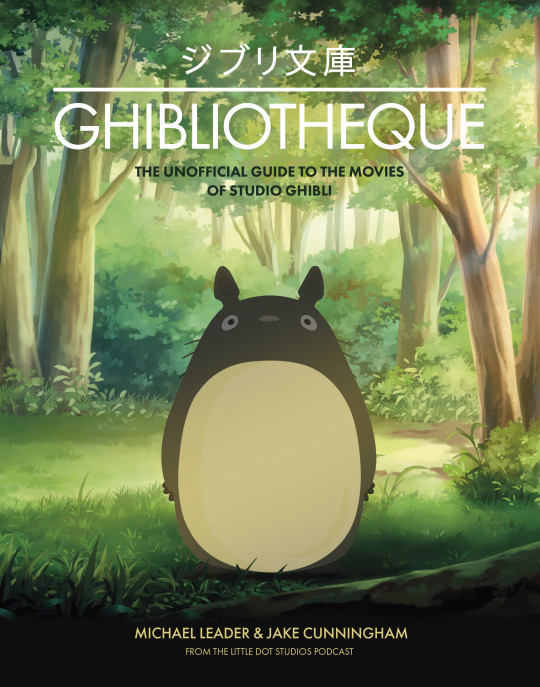
Pixar and Studio Ghibli have a mutually warm respect going back decades—the eagle-eyed will remember the Totoro plushie at Bonnie’s house in Toy Story 3—but Luca is the first Pixar feature to fully wear its Ghibli heart on its sleeve. And one thing you can always bet on is that if something carries even the faintest scent of Ghibli, Ghibliotheque podcasters Michael Leader and Jake Cunningham will sniff out the details.
Since 2018, Cunningham and Leader’s podcast has been dedicated to exploring the many lanes and landscapes of Studio Ghibli films. The hosts are also now the proud authors of a book based on the podcast: Ghibliotheque: Unofficial Guide to the Movies of Studio Ghibli.
In celebration of their publication, we invited Cunningham and Leader onto our own podcast to talk in depth about My Neighbor Totoro. In return, to satisfy the many Luca rewatchers out there, they shared with us the transcript of their Ghibliotheque conversation with Casarosa about what Luca owes to My Neighbor Totoro, Future Boy Conan and other Hayao Miyazaki classics. Read on for the highlights.
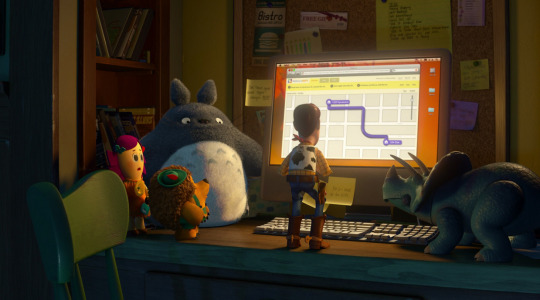
A Totoro sighting in the ‘Toy Story’ universe.
Enrico Casarosa’s first brush with the work of Hayao Miyazaki came early, predating the formation of Studio Ghibli.
Future Boy Conan is one of the first times that I remember feeling there was something special about a TV show. But I realized who Miyazaki was with Laputa: Castle in the Sky. That’s the first movie [where] I connected the dots… where I realized that that was the same artist. And that made me appreciate why I loved Future Boy Conan so much. Their choice was to have simpler characters, but move them more, which is kind of the opposite of what a lot of anime would do, which is, you know, complex robots or beautiful flowing hair.
The next step for me in Ghibli fandom was when I made my trip to really wanting to be in animation. I was in New York City, and among animation artists, there were LaserDiscs. Kiki’s Delivery Service was the one that arrived, and we were absolutely in love with. And I still remember someone starting to talk about Porco Rosso, that was the latest LaserDisc that had arrived, and having a party to watch it. We didn’t have subtitles, but seeing what Miyazaki was doing was so exciting.
Casarosa received advice from both Toshio Suzuki and Hayao Miyazaki about the Ghibli approach to storytelling.
Both Porco Rosso and Totoro have such a different sense of story, you know, and I’ve had the luck of talking to Suzuki, the producer at Ghibli, and he had this really interesting way of describing it. He said, “the shapes of our movies confound people from the West… because we build these movies, usually, like our architecture.”
He started talking about Edo architecture, where a house will be built off of a first room, and that first room is finished in beautiful detail. And then another room would be added adjacent to it, and then another room is added… and there is a sense of adding these rooms around it without necessarily knowing what the shape of the overall house will be. And he drew this really interesting thing, almost like a little puzzle. And he was pointing out that [Westerners] would come in and go “how did you get this shape of this house? This is a crazy shape!”, which I thought was a really interesting metaphor.
Another thing I actually heard from Miyazaki himself—I met him a few times in the last fifteen years—is that he really felt strongly as you take off into a story that you shouldn’t know exactly where you’re landing. He really believes in going and exploring what the story wants to be, and that the characters will tell you where they want to end.
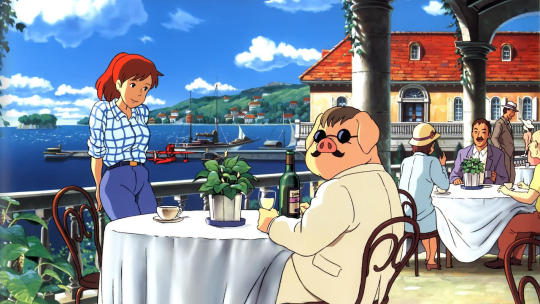
The town of Portorosso in ‘Luca’ is directly inspired by Studio Ghibli’s ‘Porco Rosso’.
Casarosa’s love of Ghibli, and a comic strip influenced by Porco Rosso, led him to Pixar.
I made the story about a flying cat called Mia Castelli who lives in Cinque Terre. I love planes, my brother’s a pilot, my best friend is a pilot too. So that’s why Porco Rosso landed so hard on me—no pun intended. But [the comic] was obviously super-inspired by Porco Rosso. That comic book was seen by a good friend, Ronnie Del Carmen, who’s an amazing story artist. So that got me to Pixar in many ways, more than the day jobs or the portfolio.
One of the reasons to go to Pixar was, “Oh, I’m going to be closer to the connection they have.” And then I get to Pixar, there’s this lovely connection. We get to have lunch with Miyazaki a couple of times. Some of the directors of Pixar directed the dubs of many [Ghibli] movies. I remember they were about to dub the rough cut of Ponyo, with a lot of stuff still in pencils. “You wanna come in? You wanna come and watch this in the screening room?” I’m like, ‘boy, if I hadn’t passed here, I would have missed this!’ I was like, “okay, that is the dream.” I just loved all these connections between the two studios.
Once Casarosa had completed La Luna, he had the opportunity to screen the short film at Studio Ghibli’s headquarters in suburban Tokyo, in the presence of Miyazaki-san.
We wanted to show it there, and we got a chance to. We got everybody in their theater and they told me to sit by Miyazaki. I don’t think I’ve ever sweated as much as that day. I was so nervous… And then there’s this silence once it’s done. Everybody’s waiting, of course, for his reaction, before anyone says anything. And he applauds, and everybody applauds, and then he said a few words. It was a crazy day.

Luca and Alberto in the fictional Cinque Terre town of Portorosso.
When it came time to make his first feature film, Casarosa was determined to make a Totoro-like story within a Pixar framework, bringing the lyrical simplicity of Miyazaki’s early works to Luca.
When you come to Luca, I guess I feel there’s obviously a sense of wonder towards nature, and a sense of being in the kids’ world that I totally wanted to bring to this movie, which is actually an interesting challenge, because we haven’t done that at Pixar.
It means sometimes slowing down a little bit of the pace of the movie, it means that you’re going to try to keep the scope smaller. So the inspiration from Totoro is pretty obvious, wanting to be in that world.
In our movie, we were really trying to get to a more lyrical simplicity, so we’re trying to take a lot of detail out, which sometimes is hard because the computer naturally wants to do realism, especially with effects like these, you know? So that was a really interesting process of deconstructing what we love of those movies, and the stylization, and bring some of that inspiration into a lot of different departments.
I wanted to show [the animators] Future Boy Conan and look at a run cycle, the timing. They were working with a lot of limits. Instead of 24 frames a second, there’s twelve or less. Maybe there’s this kind of timing that we could bring to our CG, which is more, you know, 24 frames a second, smoother. And to find a bit of its own expressive style… bringing some of that inspiration in the cartoonier, expressive [style]. And, you know, I wanted something more playful because we were with the kids.
Alberto’s tank top, as you can tell, it’s pretty much an homage [to Future Boy Conan]. It’s early Miyazaki, because there was a playfulness. When you look at Castle of Cagliostro and the running over the castle rooftops, there’s a joy in the animation, and the playfulness, that I miss a little bit in the later work.
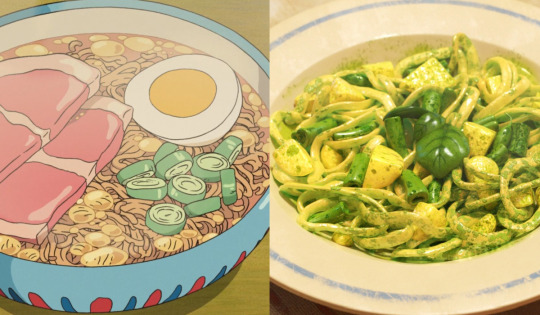
Ramen in ‘Ponyo’, trenette al pesto in ‘Luca’.
Ghibli films are renowned for their focus on food, something Casarosa and his team paid close attention to in approaching meals in Luca—particularly Massimo’s traditional Ligurian specialty, trenette al pesto.
We had many conversations, and it comes back to how do they make it look so tasty? And I think it’s just there’s a lot of care and love in the way they do it. But there’s also this kind of distilling of detail. If you took a photo of ramen, it wouldn’t look that delicious, right? Or even the tea, some milk tea with honey. It’s just done with such love, it’s simplified in a way, but beautifully detailed. There’s something amazing about that.
Design-wise, we always felt, like, how do we tone down the amount of detail? How do we take out some of the photorealism? So that it can feel a little more like a lyrical moment. Like a little poem as opposed to an essay.

Detail from the ‘Luca’ credits.
The Totoro-inspired credit roll expands the storytelling, and includes a touching wave goodbye.
We end the movie with cards, a lot like Totoro. There was something for me that Totoro did that I borrowed there, because the way that you get a little bit of closure—oh, mum comes home, and here’s the next season with Totoro, and life goes on—was something that I felt was important for our movie, where we end on this bittersweet moment, but sad as well.
So I loved the idea of telling a tiny bit more story. But if you look at my card—the first card is the only one I drew, because Nicolle Castro did all the other ones—that is a beautiful, little wave. That is very inspired by Porco Rosso and all the beautiful waves that they’ve done throughout all their movies. So that speaks to my love of Ghibli, but it speaks to my love of water, and of the region.
Related content
Ghibliotheque’s Jake and Michael discuss the arrival of Studio Ghibli films on Netflix and HBO Max in 2020
Kambole Campbell reports on Luca from Annecy 2021
Vulture’s The 100 Sequences that Shaped Animation
Follow Gemma on Letterboxd
‘Luca’ is streaming on Disney+. Comments have been edited for clarity.
#luca#pixar#studio ghibli#hayao miyazaki#my neighbour totoro#isao takahata#ghibliotheque#jake cunningham#michael leader#enrico casarosa#cinque terre#anime
27 notes
·
View notes
Photo
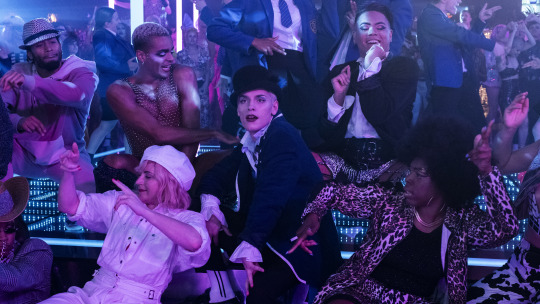
Wigging Out.
Choreographer and director Jonathan Butterell tells Gemma Gracewood about stepping behind the camera for Everybody’s Talking About Jamie, his love for Sheffield, and making sure queer history is kept alive. Richard E. Grant weighs in on tolerance and Thatcher.
Of 2021’s many conundrums, one for musical lovers is why the narratively problematic Dear Evan Hansen gets a TIFF premiere and theatrical release this month, while the joyously awaited Everybody’s Talking About Jamie went straight to Amazon Prime.
And yet, as the show’s lyrics go, life keeps you guessing, along came a blessing. There’s something about the film streaming onto young people’s home screens, with its moments of fourth-wall breaking where Jamie speaks straight to the viewer, that feels so important, given the content: a gay teen whose drag-queen destiny sits at odds with the less ambitious expectations of his working-class town.
Director and choreographer Jonathan Butterell, who also helmed the stage production (itself inspired by Jenny Popplewell’s 2011 BBC documentary, Jamie: Drag Queen at 16) agrees that the worldwide Amazon release is a very good silver lining. “I made the film for the cinema but, in 250 territories across the world, this is going to have a reach that—don’t get me wrong, cinema, cinema, cinema, collective experience, collective experience, collective experience—but it will get to people that it might not have got to before.
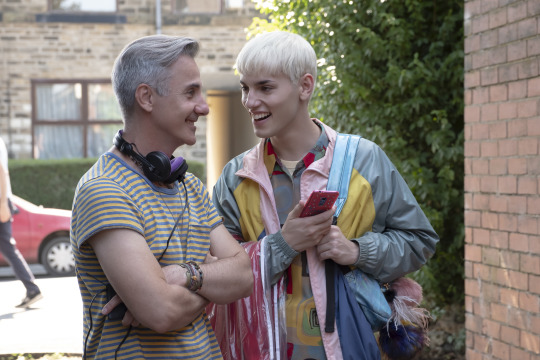
Jonathan Butterell on set with star Max Harwood, as Jamie.
“It feels as niche a story as you could possibly be. But also for me, I wanted it to feel like a universal story, that it didn’t matter where on any spectrum you found yourself, you could understand a young person wanting to take their place in the world freely, openly and safely.”
Everybody’s Talking About Jamie, with screenplay and lyrics by Tom MacRae and songs by Dan Gillespie Sells, sits neatly among a series of very specific feel-good British films about the working class experience, such as Billy Elliot, Kinky Boots and Pride. The film adds some historical weight to the story with a new song, ‘This Was Me’, which allows Jamie’s mentor, Hugo (played by Richard E. Grant), to take us into England’s recent past—the dark days of the discriminatory Section 28 laws, at a time when the HIV/AIDS epidemic was still ravaging the community.
Hugo’s drag persona Loco Chanelle (played in the flashback by the stage musical’s original Jamie—John McCrea from Cruella and God’s Own Country), sports a wig that looks suspiciously like the Iron Lady’s unmistakable head of hair. Grant confirms that was Hugo’s intention. “His heyday was in the 1980s, so as a ‘fuck you’ to Mrs Thatcher, what better than to be dressed up like that, at six-foot-eight, with a wig that could bring down the Taj Mahal!”
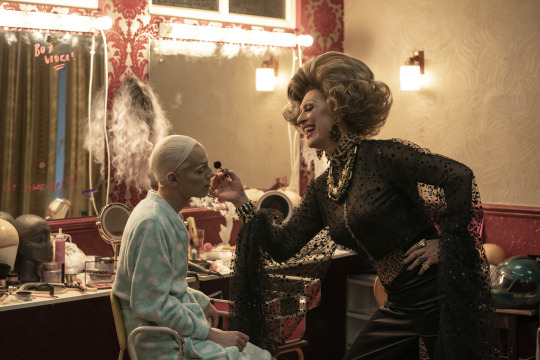
Richard E. Grant as Hugo, getting to work on Jamie’s contours.
In light of the current pandemic, and the fact that the 1967 legalization of homosexuality in Britain is only “an historical blink away”, Grant’s hope is for more tolerance in the world. “Maybe Covid gives people some sense of what that was like, but with Covid there’s not the prejudice against you, whereas AIDS, for the most part in my understanding, was [seen as] a ‘gay disease’, and there were many people across the globe who thought that this was, you know, whatever god they believe in, was their way of punishing something that they thought was unacceptable.
“The message of this movie is of inclusivity, diversity, and more than ever, tolerance. My god, we could do with a dose of that right now.”
Read on for our Q&A with Jonathan Butterell about the filmic influences behind Everybody’s Talking About Jamie.
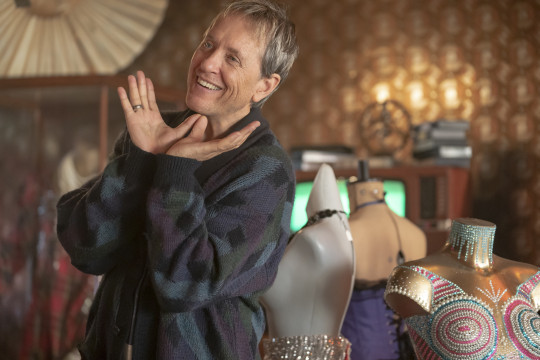
Hugo in a reverie, surrounded by his drag menagerie.
Can we talk about the new song, ‘This Was Me’, and the way you directed it in the film? It’s a show-stopper, with Richard E. Grant singing in that beautiful high register, and then moving into Holly Johnson’s singing, as you go back in time to show that deeply devastating and important history.
Jonathan Butterell: It felt inevitable, the shift, and necessary. Myself, Dan Gillespie Sells, the composer, and Tom MacRae, the screenwriter, we created this piece together, the three of us, and it’s a film by the three of us. We lived through that time, we went on those marches. Actually, in one of those marches [shown in flashback], Dan’s mum—actual mum—is in a wheelchair, by a young boy who was holding a plaque saying “my mum’s a lesbian and I love her”.
That is Dan with his mum back in the day, and it all speaks to our stories and it moves me, I can see it’s moving you. It moves me because I lived through that time, and it was a complex time for a young person. It was a time that you felt you had to be empowered in order to fight, and you felt very vulnerable because of the need to fight. And because of that disease, because HIV was prevalent and we lost people—we lost close people—it was a difficult time. I wanted to make sure that that story kept being told and was passed on to the next generation.
It’s so important isn’t it, to walk into the future facing backwards?
It still exists, that need to fight still exists. The conversation, yes, has moved on, has changed, but not for all people and not in all communities.
What would be your go-to movie musical song at a karaoke night?
My goodness. There’d be so many.
I mean, is it going to be a Cabaret, a Chicago showstopper, or something more Mary Poppins, something from Rent?
I think what I would go to, which is what I remember as a little boy, is Curly singing ‘Oh, What A Beautiful Mornin’. It’s such a kind of perfect, beautiful, simple song. That, and ‘The Lonely Goatherd’, because I just want to yodel. It would be epic. Trust me.
What is the best film featuring posing and why is it Paris Is Burning?
It’s always Paris Is Burning. Back in the day, I was obsessed with Paris Is Burning, I was obsessed with that world. In fact, at one moment I even met [director] Jennie Livingston in trying to make a theater piece inspired by that. I lived in New York for eleven years and I met Willi Ninja. I just adored everything about him, and he would tell me stories. And again, it was so removed from the boy from Sheffield, I mean so far. That New York ballroom scene was so removed from my world, but I got it. Those two boys at the top of the film, I just wanted to be one of those boys who just hung out outside the club.
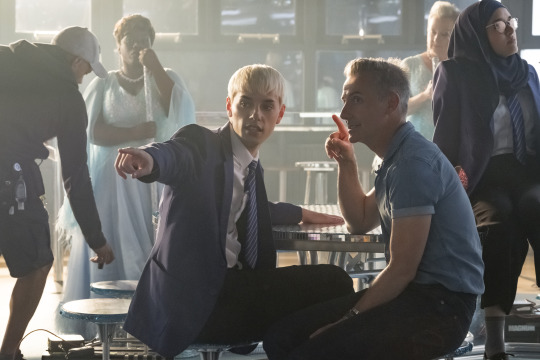
Harwood and Butterell on set, with Lauren Patel (right) as Jamie’s bestie Pritti Pasha.
What films did you and Tom and Dan look at to get a feeling for how to present the musical numbers?
Actually, a lot of pop videos, from present day to past. There’s an homage, in the black-and-white sequences, to a little ‘Vogue’ Madonna moment. Pop is very central to me in this story because pop is what a working-class kid from a working-class community will be listening to. That’s in his phone, that’s in his ears. Not that many young people listen to much radio at this moment in time, but that’s what will be on Margaret’s radio, that’s what’s coming into the kitchen. And that was central to the storytelling for me.
Bob Fosse also really influenced me, and particularly All That Jazz and where his flights of imagination take him. I felt that was so appropriate for Jamie, and again in a very, very different way, but I could see how Jamie’s imagination could spark something so fantastical that would lead him to dance, lead him to walk on the most amazing catwalk, lead into being in the most fabulous, fabulous nightclub with the most amazing creatures you’ve ever met in your life.
For me personally, the film that most inspired me was Ken Loach’s Kes, because that is my community. Both the world in which Jamie exists—Parsons Cross council estate, is my world, is my community—and the world of that young boy, finding his place in the world with his kestrel friend, I remember identifying with that boy so clearly. He was very different from me, very different. But I got him, and I felt like Ken Loach got me through him.
Ken Loach made a few films set in Sheffield, didn’t he? But also, Sheffield is a setting and an influence on The Full Monty, The History Boys, Funny Cow and that brilliant Pulp documentary. So Jamie feels like a natural successor.
It absolutely does. Sheffield’s where I grew up, it’s my hometown. Although I moved away from it, I always return. To have a chance to celebrate my community, and particularly that community in Parsons Cross council estate. If you’re in Sheffield and you’re in a taxi and you said, “Take me to Parsons Cross,” they’d say, “Well, I’ll drop you there, but I’m not staying.” Because again there’s a blinkered view of that community. And I know that community to be proud, glorious and beautiful.
And yes, that community, particularly through the ’80s, really suffered because some of that community would serve the steelworks and had three generations of unemployment, so they became disenfranchised because of that. But the community I grew up in, my Auntie Joan, who lived on that road, literally on that road, was a proud, working class, glorious woman who served chips at school.
Aside from Everybody’s Talking About Jamie, what would be the most important queer British cinematic story to you? (And how do you choose between My Beautiful Laundrette and God’s Own Country?!)
You can’t. My Beautiful Laundrette influenced me so much because, one, Daniel Day Lewis was extraordinary in that film, and two, because of the cross-cultural aspect of it. I went, “I know this world”, because again I grew up in that world. And it affirmed something in me, which is the power and the radicalness of who I could be and what I could be.
With God’s Own Country, when I saw that film—and that was Francis’ first film, which I thought was extraordinary for a first-time filmmaker—I knew he knew that world from the inside, from the absolute inside. And I know what that rural community was like. I read that script, because we share agents, and I was blown away by it—again, because of the two cultures coming together.

Jamie Campbell, the film’s real-life inspiration, with screen-Jamie Max Harwood.
Richard E. Grant’s character, Hugo, is such a pivotal mentor for Jamie. What did you need to hear from a mentor when you were sixteen?
Don’t let yourself hold yourself back, because I think it was me who put some limitations on myself. And of course I came from a working-class community. I was a queer kid in a tough British comprehensive school. And did I experience tough times? Yes I did. And did I deal with those tough times? Yes I did. But the song that speaks to me mostly in this is ‘Wall in my Head’, in which Jamie takes some responsibility for the continuation of those thoughts, continuations of the sorts of shame, and that’s a sophisticated thing for a sixteen-year-old boy to tackle.
I also was lucky enough to have a mother like Margaret—and a dad like Margaret as well, just to be clear! And I remember my mum, at seventeen when I left home, just leaving a little note on my bed. It was quite a long letter. She said, Jonathan, you’ve probably chosen to walk a rocky path, but don’t stray from it, don’t steer away from it. That’s the path you've chosen, there may be rock-throwers along the way, but you’ll find your way through it. That stayed with me and I think that’s what resonates with me. And when I saw that documentary, Jamie: Drag Queen at 16, I felt that that sparked the need for me to tell that story.
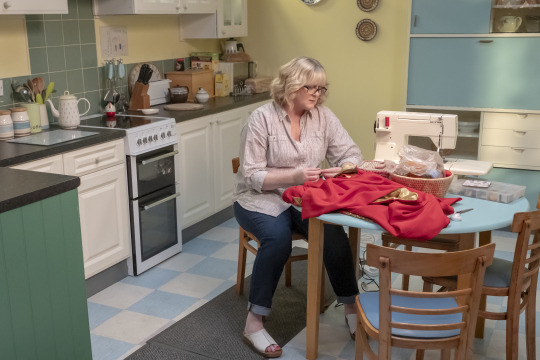
Sarah Lancashire as Jamie’s mum, Margaret New.
We need more mums and dads like Margaret, don’t we?
We do, we do. And the wonderful thing is, Margaret Campbell will say it and I think Margaret New in the film will say it: she’s not a Saint, she’s an ordinary mum. And she has to play catch up and she doesn’t understand in many ways, and she gets things wrong and she overprotects. But she comes from one place and that is a mum’s love of her child and wanting them to take their place safely in the world and to be fully and totally themselves.
Related content
Eternal Alien’s list of films Made in Sheffield
Letterboxd’s Camp Showdown
Persephon’s list of films recommended by drag queens
Passion’s list of films mentioned by Jaymes Mansfield in her Drag Herstory YouTube series
Follow Gemma on Letterboxd
‘Everybody’s Talking About Jamie’ is streaming now on Amazon Prime Video.
#everybody's talking about jamie#max harwood#john mccrae#richard e. grant#sharon horgan#jonathan butterell#musicals#drag queen#queer film#lgbtqia cinema#british cinema
18 notes
·
View notes
Photo
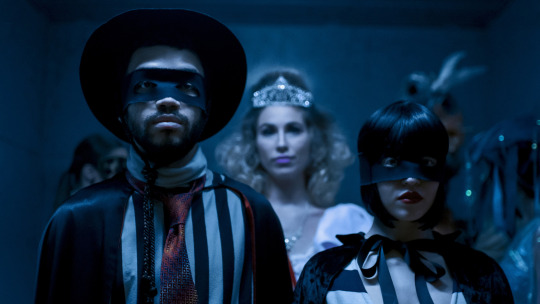
Hot in the City.
Steamy subgenre enthusiast Justine Smith chats with filmmaker Michael Mohan about how his new feature, The Voyeurs, taps into the excesses and fun of erotic thrillers past.
“I think you can only enjoy the film if you know that the people involved have agency and a real voice in how their bodies are shown.” —Michael Mohan
Each city represents new opportunities—a chance to rewrite your history. In the realm of the erotic thriller, cityscapes offer their characters chance encounters, voyeuristic indulgences and new identities.
While there are notable erotic thrillers that take place in backwoods and small-towns, the most emblematic films of the genre unfold under the shadows of skyscrapers, crowded underground interiors, and vistas overlooking ant-like citizens going about their day. It’s a landscape of anonymity, of possibility and doppelgangers. You are a part of the crowd and also desperately lonely.
With The Voyeurs, director Michael Mohan brings the erotic thriller to Montréal, Canada. Director of photography Elisha Christian—who brought to life the crisp retro-futurism of Indiana’s modernist culture in Columbus—presents a new, charged vision of a city gripped by the contradictions and opportunities of its past. Stuck between its colonial beginnings and a modernist vision of a future that never came to be, Montréal’s skyline and narrow streets lend the film a cozy claustrophobia. As the snow begins to fall, it’s easy to understand why its characters retreat to their small, interior worlds.

The film is about a young couple, Pippa (Sydney Sweeney—Nocturne, The White Lotus, Euphoria) and Thomas (Justice Smith—Jurassic World: Fallen Kingdom), who move into a too-good-to-be-true apartment. It doesn’t take long for them to notice the couple across the way, having sex. For Pippa especially, curiosity turns to obsession, especially as she realizes that the man may be cheating on his wife. Rather than let it go, she decides to take action in the real world, much to the chagrin of Thomas.
The Voyeurs draws heavily on a legacy of erotic thrillers, and (as the film title suggests) it reflects on the prurient impulse to sit in a dark room and spy on people’s lives. By integrating a backdrop of social media and new technology, it also taps into the artifice of contemporary life and the act of living vicariously through the catered reality of others.
Above all else, though, The Voyeurs taps into the excesses and fun so emblematic of films like Basic Instinct, Body Double and Indecent Proposal. Its many intimate scenes serve to advance character and plot functionally and gleefully. It’s a movie that embraces style and color as it dives deeper into the fractured psyches of relationships on the brink of collapse, asking the audience, “what would you do?” and inviting us to implicate ourselves in its crimes.
Over Zoom, Mohan spoke to Letterboxd about the invaluable presence of intimacy coordinators, the performative nature of the social-media age, recreating Montréal on a sound stage, and the fun of writing a “steamy moral-dilemma movie”.

Sydney Sweeney and Justice Smith keeping tabs on their neighbors.
You directed, but you also wrote the screenplay. Do you want to talk about the inspiration for the script?
Michael Mohan: It all started about ten years ago. I made these two short films, one of them is called Ex-Sex, and the other is called Pink Grapefruit. Both explore the notion of using sex as story, where the narrative pushes forward through the act of sex, or character revealed through sex. Often when you see a sex scene in a movie, it’s obligatory, you can cut it, and it doesn’t need to be there. It’s often quite chaste, or they all have the same emotional tenor. It’s movie sex. In real life, sex is sometimes sad, and it’s awkward, sometimes it’s funny, and it’s rarely depicted as such. In those short films, I experimented with those ideas and to see if it worked.
We were lucky enough to screen at Sundance, and when you were sitting with the audience, you could feel the temperature rise. I knew I was onto something. Around that time, I discovered what I will now call the “lost genre of erotic thrillers”. They’re films I describe as junk food, but junk food that’s secretly healthy for you. They’re so easy to watch, and at the same time, the smart ones incorporate elevated themes and elevated character dynamics.
At this point, I do this thing that comes very instinctually to me, where I take what I’ve learned from these $2,000 short films and simultaneously bring back this genre and reboot it for a modern audience.
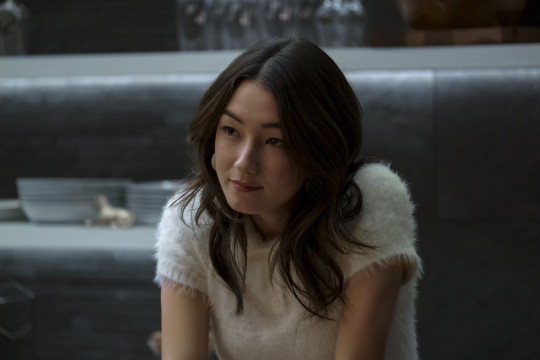
Natasha Liu Bordizzo in ‘The Voyeurs’.
Where are you from?
I’m originally from south-eastern Massachusetts, but I’ve been living in Los Angeles.
How did you come to make a film in Montréal, Canada?
Montréal is such a great city. The film was originally written for Downtown LA. I visited a friend who had just moved into a loft space downtown, and I looked out his window, and across the street, there was this couple wandering around their apartment completely naked. I looked at him, “do you know that they’re naked?” And he’s like, “yeah, they’re naked all the time. We just all co-exist here.” He had these vintage binoculars and asked if I wanted to take a look. I said no, I wanted to, but I shouldn’t!
The spark came from that and figuring out how to create a believable reality where you have these two apartments side by side. It was a giant technical challenge. We knew we would have to build two sets in a giant sound stage. There wasn’t a sound stage big enough and available anywhere in North America except for Montréal. We went and started scouting. The city was just so beautiful, multicultural; there’s just so much beautiful texture that I fell in love with.
I was shocked. There’s a whole industry there, many French Canadian TV shows and movies are made in Montréal, though [in the States] we only get a small fraction of them. I thought, “Why would we want to hide this? Why don’t we embrace it?”
We had a local crew, and when we’re trying to build shots and pick our locations, we’d suggest things like, “how about a drone shot of the Five Roses Sign”, or, the character walks in front of the Notre-Dame cathedral, and all the locals were like, “dude, you can do that, but that’s just for tourists. You need to show the real Montréal.” So hopefully, we avoided all those tropes.
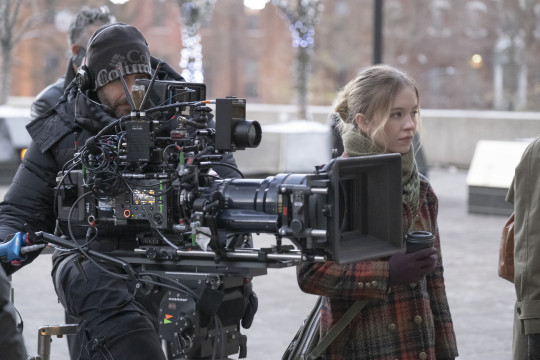
Cinematographer Elisha Christian and Sydney Sweeney on the Montréal set.
The film is shot by Elisha Christian, who, among other notable films, shot Columbus, a film that centers beautifully on the modernist architecture of Columbus, Ohio, as a backdrop to this budding romance. What is your working relationship like and how did you craft the look of The Voyeurs?
Elisha and I were roommates in college, and we’ve been working on movies together for a long time. He shot my student films, and he shot my first feature, which was made for $20,000. We’ve almost worked exclusively together and developed this language. I’m always a little jealous when he works with other directors, and Columbus is so good, and it’s also so Elisha. It’s just how his brain works.
Even though erotic thrillers inspired us, we were also inspired by many other films—obviously, Rear Window. Visually, we drew on Coppola’s The Conversation, Blow-up and Klute. Also, the work of this photographer, Gail Albert Halaban. She has a series of photographs called ‘Out My Window’— tableaus where you see a person through a window.
There’s style in the movie, but we wanted to make this as grounded as humanly possible in the visual sense. Artifice is already such a big part of it because we’re on a stage, and one side of it is just this giant matte painting of the Montréal skyline. Everything we did, we approached by asking ourselves, “How do we ground this? How do we make this relatable?” Keeping the colour palette natural and trying to keep the quality of light as natural as possible was the goal even though we’re in the most unnatural setting.

Sydney Sweeney in ‘The Voyeurs’.
The film features several sex scenes and intimate acts. Your team worked with Amanda Blumenthal, an intimacy coordinator. Can you discuss the process of working with her on the film?
In 2021, the world has become a much more empathetic place. When you make a film like mine, where we want to make things as visceral as possible, I think you can only enjoy the film if you know that the people involved have agency and a real voice in how their bodies are shown. I always try to involve the cast and learn about people’s boundaries by setting expectations and ensuring those expectations are met.
The great thing about having an intimacy coordinator is that even though I consider myself a pretty down-to-earth and approachable person, no matter what, there’s a power dynamic. When a director asks or suggests an actor do something, for the actor who wants to please the director, it can be difficult for the actor to say, “No, I’m not comfortable with that.” The intimacy coordinator provides a completely safe and judgment-free environment for those conversations to transpire without me.
The intimacy coordinator takes those conversations and discreetly communicates the information to their scene partners or me. Then I can develop the shot design with Elisha to capture that as sensually as possible. Amanda is invaluable in a movie like this one and a large reason why these scenes are so visceral. It’s because of the actors’ bravery, but also because of the way Amanda was able to have those conversations sensitively.
One thing about some of the most noted erotic thrillers is a kind of maximalism in style. One of the ways you carry that over in this film is through these clever and fun transitions, such as eyes cutting to eggs. Can you discuss the inspiration for these transitions?
The last feature film I made was in 2012. I directed this film as if it were my last. A big influence was De Palma’s Body Double, a movie that throws everything and the kitchen sink onto the screen. Even though the film can be dark and allegorical, I knew above all else I wanted it to be fun. For me, stretching my filmic muscle is to give things to the audience and give them a little chuckle as you go into the next thing. We’re going through these dark places, but you want to permit them to enjoy the ride.
For me, erotic thrillers fall into three main categories. That term can mean different things to different people. Some people call movies like Body Heat or Wild Things erotic thrillers; I call them the ‘sweaty neo-noirs’. You might think of films like The Hand that Rocks the Cradle, a nanny from hell, or Single White Female, a roommate from hell. But, I think ours is the third film, which I call the ‘steamy moral-dilemma movie’. Movies like Unfaithful or Indecent Proposal.
The line between all these subgenres is a bit blurry, but the fun of the [moral-dilemma] movie is that it asks questions to the audience. If you were to put yourself in the characters’ shoes, what would you do? I remember walking out of the cinema after Indecent Proposal and people asking themselves if they would sleep with Robert Redford for a million dollars. My real hope is that people will have fun arguments within this canon of erotic thrillers after the movie is over.
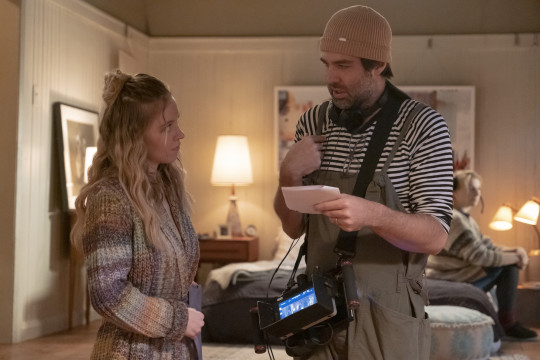
Sydney Sweeney on set with writer-director Michael Mohan.
The film also embraces the current time and seems to comment on the performative nature of our present age without being too obvious about its intentions. Was it challenging to write a film that incorporates social media elements and how it impacts our behavior?
We incorporated it naturally. Every film is a product of a time. I knew the themes of the movie were both timely and timeless. I think all of us have experienced the ‘grass is greener’ syndrome. Even if you’re in a committed relationship, those feelings permeate. But, it’s never been more intense than it is right now. We all have little apps in our pockets that allow us to spy on people whenever we want. Or, we discover someone who intrigues us, and we fall down a rabbit hole, looking through someone’s curated history.
We know it’s not real; we know there are filters and face-tunes, that so much of this reality is unattainable, but we still sometimes feel dissatisfied by our own lives because of it. I hope that people can watch the film and don’t read any of what you’re saying into it. Though I intend to explore those ideas, I hope people can enjoy the film at face value.
Related content
The Best Horny Movies for Quarantine: the definitive list from Justine Smith
Kate Hagen’s list of Essential Erotic Thrillers
Lockdown Thirst: the erotic-thriller episode of The Letterboxd Show podcast, featuring Kate and Justine
Erotic Thrillers Forever: Justin LaLiberty’s selection
The ranked list of films that have featured on the Fatal Attractions podcast
Follow Justine on Letterboxd
‘The Voyeurs’ is now on Amazon Prime.
#the voyeurs#sydney sweeney#justice smith#natasha liu bordizzo#erotic thriller#erotic thrillers#justine smith#justine peres smith#canadian cinema#montreal#steamy films#fatal attraction#fatal attractions#body double#indecent proposal#robert redford#letterboxd#brian de palma
2 notes
·
View notes
Photo

Poker Face.
Tiffany Haddish tells Gemma Gracewood about taking a holiday from comedy in Paul Schrader’s The Card Counter, her hotel comfort viewing, and why Oscar Isaac thinks of her as Jesus.
“When I say yes to a movie, that’s a hundred to two hundred people that get to work and I want them to be happy about working.” —Tiffany Haddish
Comedians taking on dramatic roles is not an innovation in cinema, but it’s which comedian, in which role, that makes a casting choice a talking point. Melissa McCarthy in Can You Ever Forgive Me? Mo’Nique in Precious. Peter Sellers in Being There. Robin Williams in everything.
In The Card Counter, Paul Schrader’s meditative slow-burn on American shame, part of the tension as a viewer lies in what we already appreciate about Tiffany Haddish as a performer. She is an unbridled crack-up, a live wire on screen and off, a former foster kid committed to busting unsustainable Hollywood beauty myths by wearing the same dress throughout an awards season. Her physical comedy is electric, even when it’s a simple raise of an eyebrow.
The wildest thing about La Linda—a gamblers’ agent working the mid-level casino circuit, who spies, in Oscar Isaac’s William (Bill) Tell, a potential new thoroughbred for her stable of card counters—is the way her drinks order changes from hotel bar to hotel bar. “I came in there with my comedy ways and it sucked,” Haddish laughs, disarmingly honest about her leap from the hi-jinks her fans know her for, to her dramatic role in Schrader's new film. “Paul was hard on me at first,” she recalls. “He had to reel me in, make adjustments, strip all this stuff off, all my tools, leave me with these instruments I barely ever use.”
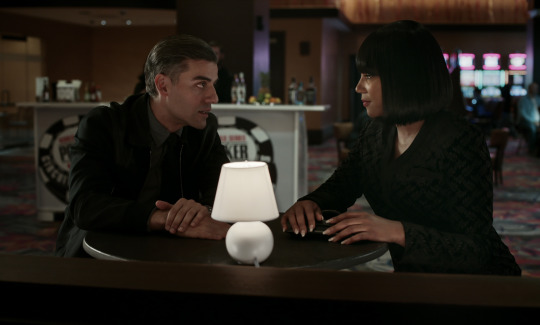
Oscar Isaac and Tiffany Haddish in a scene from ‘The Card Counter’.
There’s an enduring myth that drama is tougher to pull off than comedy, something Haddish’s friend Morris Chestnut corrected her on a few years back. “He’s like, ‘No, what you do, that’s hard work. You are actually overworking yourself, doing these comedies.’ And I’m like, ‘He don’t know what he’s talking about.’ Then I actually did a drama. And I was like, ‘Oh, that was so easy. Oh, that was beautiful.’ It’s way easier. It’s way easier.”
What La Linda doesn’t know, but any casual observer of Schrader’s work will, is that Isaac’s Bill has a past, and that his methodical attempts to keep his guilt in check through a supremely minimal lifestyle, perhaps even to allow himself a spark of pleasure—redemption, even—are about to come unwound.
Before that, though, there’s time for La Linda, Bill and Cirk (Tye Sheridan)—the son of one of Bill’s former, shall we say, colleagues—to become an odd little chosen-family unit as they travel the circuit. Bill and La Linda cook up a nice heat while killing time in cocktail lounges, and her casual business charisma is a charming offset to the deeper themes at play. Writing fresh from a Venice Film Festival viewing, Rahul notes “you keep expecting Haddish to break out of the understated style and that tension works.” Andy agrees: “Her simple outlook on life and lack of existentialism offer a nice contrast to Tell’s brooding sorrow. Plus, La Linda is just a great character name.”

Haddish understood the pull between Bill and La Linda, and La Linda’s desire to probe into his mysterious monotony, in a very specific way: “As a standup comedian, I work with a lot of men that—they’re very talented, they’re doing big things when they’re on stage—but then when they come off the stage you’re like, ‘Who are you? Why are you so dark? Who hurt you? What’s going on?’ I can relate to that in so many ways.”
Still, of all the dramatic writer-directors to work with in America, why Schrader? What was it about his specific brand of lonely-white-man stories that appealed? “Cat People. It’s my jam,” declares Haddish, of Schrader’s 1982 erotic horror reimagining of the 1942 classic (and one of his few films with a female lead, played by Natassja Kinski). “I love that movie. It had some weird, twisted shit in it.” She has been campaigning Schrader to mount a sequel, so that she can have a crack at playing a sexy, predatory jungle cat. “I try to bring it up to him all the time. And he’s like, ‘Tiffany, we’re not doing it. No.’”

Natassja Kinski in Paul Schrader’s 1982 remake of ‘Cat People’.
Haddish imagines that Cat People would certainly be on La Linda’s list of hotel-room comfort watches, along with Shaft and Goodfellas. Haddish, on the other hand, prefers to kick back with series television when she is on the road. “I watch old sitcoms like Martin or, like, The Facts of Life. I love a good cartoon, especially the throwback ones on Boomerang. I really like the old school, like ThunderCats. That’s a good wind down for me.”
Filming days are long, making the minutes can be stressful, and Covid safety protocols add layers of complexity to the job. There are performers who are cast not only for what they bring to their roles, but also for the energy they bring to set. Haddish has an undeniable magnetism, so it is unsurprising to read her co-star Isaac, in The Card Counter’s production notes, describe her as being “like Jesus”, in that people would drop everything and follow her. She enjoys this comparison, revealing that she has always wanted to be an AD, the crew member with, traditionally, the greatest people skills. “I always wanted to be assistant director just so I can be like, ‘All right, picture’s up, guys.’ And just so I can know everybody and be cool with everybody.”
But as a performer with clout, what is her intention when she—Tiffany Haddish, famous actress™—walks onto a soundstage? Haddish’s answer is a generous primer on how to be a good sort on set (or, indeed, in any working environment). “When I say yes to a movie, that’s a hundred to two hundred people that get to work and I want them to be happy about working,” she explains. “I’m going to work with them again in something else, and I want to have a pleasant experience with the crew. The DP, the gaffers, all these people, we all work together as a unit, so I think it’s super important.”
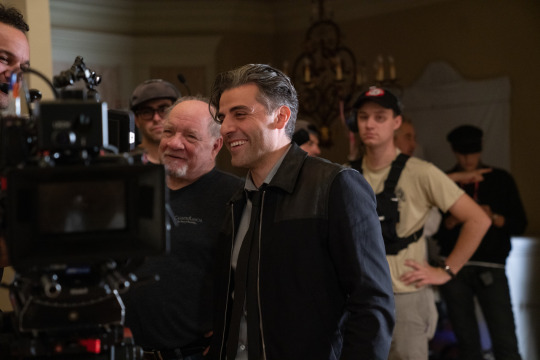
Paul Schrader, Oscar Isaac and crew on the set of ‘The Card Counter’.
Certain crew members, she admits, “are imperative to making me look good”, but more than that, her approach is grounded in her own physical and emotional safety in an often volatile and unpredictable creative environment. “I see how some actors won’t talk to any crew members at all, and I feel like that’s not okay because these people are busting their ass to make you look great, and they are part of telling this story too. They might not be hanging off the side of the building like you are, but they are making sure that the camera’s operating correctly, so you don’t have to shoot it five hundred times.
“These people keep me alive. They keep me going and they can tell when I’m in a bad space. They’re like, ‘Here’s a Snickers.’ If I’m working with an actor who might be treating me not the best, they’re coming over, they’re giving encouraging words, ‘You’re going to be okay.’ We’re a team. I even talk to the editor. They’re like, ‘Picture’s up, sound’s rolling, and speed.’ And I’d be like [staring down the camera lens], ‘What’s up editor? Hey, it’s your girl Tiffany Haddish. Just a little note: I’m thinking about you. Now, if you could just make sure this lazy eye is this way… I know you’re in that room by yourself, but look out for your girl.” Sometimes, Haddish will even throw a bone to the studio executives. “I know they’re watching the dailies,” she laughs.
Her investment in the welfare of her film families is paying off in unexpected turns such as The Card Counter, with more to come. Up next, a trio of unusual comedies: Jerrod Carmichael’s existential buddy farce On the Count of Three, which was picked up by Annapurna out of Sundance this year; Cory Finley’s surrealistic sci-fi romp Landscape with Invisible Hand; and the intriguing Nicolas Cage vehicle, The Unbearable Weight of Massive Talent.
Related content
A list of favorite gambling movies from Gamblers, a podcast from The Big Picture’s Sean and Amanda
Life Detained: Jack Moulton’s interview with Kevin Macdonald, director of The Mauritanian
Josh’s list of Neo-Noir films
Follow Gemma on Letterboxd
‘The Card Counter’ is in US cinemas now.
#the card counter#paul schrader#tiffany haddish#cat people#oscar isaac#tye sheridan#gambling movies#neo noir#girls trip#actress#Black actress#letterboxd#gemma gracewood#morris chestnut#filmmaking tips#goodfellas
11 notes
·
View notes
Photo

Eva After.
As Evangelion 3.0+1.0: Thrice Upon a Time raises the bar of Letterboxd’s Top 250, Kambole Campbell assesses the (probably) conclusive end of Hideaki Anno’s Neon Genesis Evangelion masterwork.
Neon Genesis Evangelion has concluded no fewer than three times, but its latest ending—the very last?—is resonating with the Letterboxd community more loudly than usual.
Evangelion 3.0+1.0: Thrice Upon a Time is the culmination of Hideako Anno’s ‘Rebuild of Evangelion’ series. Since its August release on Amazon Prime Video, it now sits at number 90 on our Official Top 250 Narrative Feature Films list (1997’s The End of Evangelion is at 25). More than that, Thrice Upon a Time has raised the bar of the Top 250, raising the prestige list’s minimum rating to 4.2 out of five stars, by pushing out the last 4.1. Thrice up!
Even after stellar directorial work in live action—the wild, handheld experimentations of Love and Pop (1998), the haunting reflections on loneliness and escapism of Ritual (2000, starring fellow director Shunji Iwai), and the incredible mix of bureaucratic satire and gross monster action of Shin Godzilla (2016)—Evangelion is still probably Anno’s most popular and most discussed work.

For those yet to get in the fucking robot, Evangelion transports the viewer into a world ravaged by the mistakes of the previous generation and left to the youngest to save what’s left, fifteen years after a worldwide cataclysm. An anime series broadcast on Japanese television from 1995 to 1996, Neon Genesis Evangelion centers around troubled teenage boy Shinji Ikari. He is recruited by his absentee father Gendo to pilot a giant robot (that’s not really a robot) called an Eva, to fight the monstrous enemies called Angels, which are attacking the futuristic city of Tokyo-3.
The series’ first finale was notorious for its weird abstraction, which came in part from working with restrictions, the production out of money by its end. Eventually, the finale got a do-over in the 1997 film Neon Genesis Evangelion: The End of Evangelion, an aggressive assault on the senses that took a more visceral route to a similar emotional conclusion. Thrice Upon a Time, Evangelion’s third finale—and the fourth Rebuild film—looks to revisit all of its endings and leave the series behind, for real this time. Probably.
The very premise of the show, and subsequently the films, is a love letter to Anno’s favorite TV shows, the tokusatsu franchise Ultraman perhaps most prominent among them. Thrillingly, Anno is the screenwriter of the upcoming Shin Ultraman and writer/director on Shin Kamen Rider—and he’s finally free from the tyranny of Eva to make these things.
Evangelion is just as jovial and goofy as such shows, but also frequently turns some of the pleasures of mecha and giant-hero series on their heads. ‘An Unfamiliar Ceiling’, the second episode of the original Evangelion series, might be one of the best examples of this, as it immediately cuts to the aftermath of the first battle, and fills the episode instead with long, eerie silences and still frames.
As well as its lasting popularity and its status as a go-to in many a ‘must-watch’ anime list, both the show and the films found a renewed surge in viewership in mid-2019, when Netflix acquired the international streaming license for the original series, the recap films, and finale film The End of Evangelion (all of which are soon to get their first international home Blu-ray release as well). They landed on the streamer in June 2019, and by that July, Letterboxd data showed a clear bump in logged views and watches—the "Netflix effect” in full flight.

The Rebuild trilogy saw a similar spike in Letterboxd numbers in August this year, as fans and newcomers alike watched and rewatched in preparation for the storied fourth film.
Looking through the highest Letterboxd ratings for this, er, final finale, we can see fans reassessing the series as a whole through Evangelion 3.0+1.0: Thrice Upon a Time. In this last film especially, Neon fans take into account what Anno himself was going through and intending. Thrice Upon a Time invites wide interpretations, but a number of writers focus, lovingly so, on how it’s the work of a changed man.
Esther writes: “EoE felt like a pure product of Shinji’s mind, and 3.0+1.0 feels more like a product of Gendo’s: desperately grasping for domestic peace, and as narratively chaotic as it is aesthetically straightforward.” Juan, who has followed the series for the greater part of their life, writes: “It took Anno 26 years to figure out how to let the story he’s been telling come to a close, for his characters to be happy and finally embrace existence by experiencing life and other people, and it took me nearly 30 years to do the same.”
Zach, already three viewings in and frequently moved to tears, feels that the finale is: “Evangelion rebuilt and rephilosophized until it breaks and shatters and reiterates itself in an essential new form: understanding the pain of codependency and feeling, forging it into an exuberant lust for life where every human you’ve ever known has always been a part of you and will be forever.”
If this is all too much for you, we can always rely on Yi Jian to get to the point: “Anno said please for the love of god forget about my work and go outside for once.”

A wooden set from ‘Evangelion 3.0+1.0: Thrice Upon a Time’.
Appropriately—as Thrice Upon a Time is itself a reflection on Anno’s own career—the conclusion encompasses every ending of Evangelion there’s ever been (even the manga!). There are moments that channel Anno’s love of toku shows; patented playfulness with digital imagery; the mashing together of mediums. One such delightful instance of that meta and unpredictable Evangelion staging is a trip into what’s called the “anti universe”, a space the characters can’t fully perceive. We see a series of wooden sets and sound stages replicating Evangelion locations, quite literally laying out Evangelion’s inspirations in Anno’s aforementioned love of toku shows.
“In the midst of the over-precise maximalist hellscape we’ve spent so much time with, we’re finally able to slow down, to breathe,” writes Sean, of the effect of this staging. “Even the animation shifts because we’re finally seeing the world as it should be—the landscapes become less precise, more impressionistic, lending themselves to a tender beauty rather than the previously cold aesthetic… All that expresses a better world: a world without Evas because that’s the world Anno wants.”
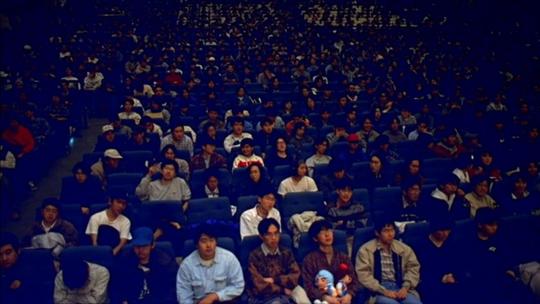
Live audience detail from ‘The End of Evangelion’.
It’s a recollection of how both the original series and then the finale film The End of Evangelion stripped away all the shading work and even in-between drawings to remind us of the personal touch of the artists. All three finales emphasise the porousness of the boundary between the work and the audience, the work and the creator—The End of Evangelion even making the switch to live-action, reflecting a cinema audience back at itself.
For all its sci-fi complications and Biblical implications—the transgression of man upon heaven and hell—Gendo Ikari’s nightmarish plan for human salvation ultimately lies in the same impulse that Shinji has, to flee from that which would hurt him. Thrice Upon a Time stands apart from the other entries in this long-running franchise thanks in no small part to the fact that it’s the most Gendo ever explains himself. He has his own Evangelion finale moment in realizing that the world he was building would also isolate him from his potential to be happy. And, as Anno has been telling us (and in part himself) for nearly 30 years, you always have that chance.

It’s a big and unwieldy undertaking, but this feels fine. If anything, it leans into this, and revisits the rough-hewn nature of the finale to the TV show (episodes 25 and 26). Incomplete drawings and animatics break down and reform exciting meta moments that visualize the scenery of the characters’ lives as something staged, drawing attention to its own theatricalities and the voice of the author. There’s even a new emotional meaning brought to the ‘Neon Genesis’ part of the title, in a way that will make some roll their eyes and others (me) applaud with delight.
The two-part television finale and The End of Evangelion are often presented as an either-or choice. Those who prefer the original praise its seemingly more empathetic presentation, while the film often wins favor because of its comparatively higher-budget thrills and bewildering aggression. For my money, rather than being a binary choice between two drastically different conclusions, both endings are complementary, and far more alike than people give them credit for.
Thrice Upon a Time is a final realization of this, synthesising all Evangelion endings: Shinji’s self-acceptance, his acceptance of the pain that comes with living, finally allowing himself to move forward.
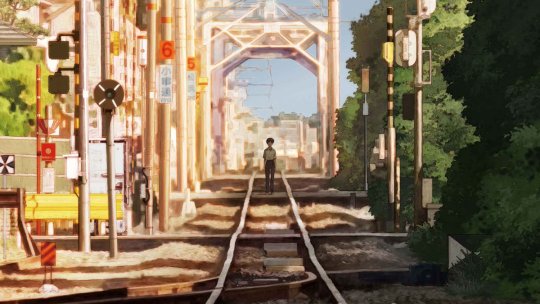
Related content
The Official Top 250 Narrative Feature Films: a list by Dave Vis
Harry Blair’s Evangelion Order Guide for Newcomers
Things to watch after The End of Evangelion: a list by A Passing Visitor
Follow Kambole on Letterboxd
‘Evangelion 3.0+1.0: Thrice Upon a Time’ is on Amazon Prime Video.
#kambole campbell#hideaki anno#eva#evangelion#neon genesis evangelion#evangelion 3.0+1.0#rebuild of evangelion#end of evangelion#shunji iwai#gendo#shinji ikari#gendo ikari#mecha#anime#japanese anime#japanese cinema#shin godzilla#shin gojira#toku#shin ultraman#ultraman#shin kamen rider#letterboxd#animation
21 notes
·
View notes
Photo
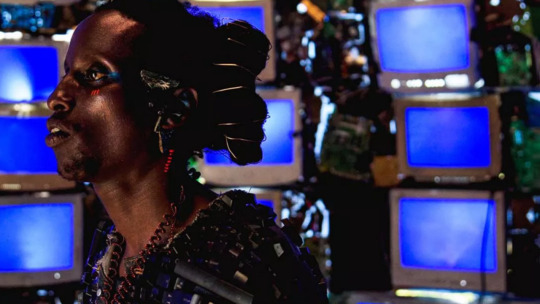
The Eyes of TIFF.
Programmers for the 46th Toronto International Film Festival chat about the degrees of intensity they look for in a festival film, and help us zoom in on the gems from TIFF’s 2021 program, by genre and region.
“Intensity can be achieved in so many different ways. I know it when I feel it. You feel it in your gut.” —Cameron Bailey
It’s almost business as usual for TIFF this year. In-person events and red carpets return, but a healthy virtual program is also available for Canadian-based folk unable to travel, as the Covid-19 pandemic continues its onslaught.
TIFF co-head and artistic director Cameron Bailey has been with the festival for just over half its life, and says while some of the technology has changed in that time—“you’re no longer sitting in front of a TV monitor with VHS tapes… or waiting for 35mm prints to be spooled up and projected for you”—the “basic process of falling in love with movies” has not.
It’s a challenge, Bailey says, to winnow down the films he falls in love with for the final TIFF lineup. And even then, it is an annual challenge for film lovers tight on time to narrow down their own selections. So, ahead of the fest, Bailey joined fellow TIFF programmers for a Twitter Spaces conversation with our editor in chief Gemma Gracewood, in order to help Letterboxd members make some watchlist decisions.
Joining Bailey were Thom Powers (TIFF Docs), Peter Kuplowsky (Midnight Madness), Robyn Citizen (senior programming manager), Diana Sanchez (Special Presentations, Spain, Latin America, Portugal and the Caribbean), Diana Cadavid (International Cinema) and Nataleah Hunter-Young (Africa, “the Middle East” and the Black Diaspora).
Edited highlights of the conversation follow, so have your watchlists close at hand.

‘The Eyes of Tammy Faye’, written by Abe Sylvia and directed by Michael Showalter.
Thank you all for joining me today. You watch a lot of films as you’re going through the selection process. How does one make itself stand out to you?
Cameron Bailey: For every programmer it’s going to be something different. For me, it comes down to an intangible quality of intensity. That can be emotional intensity, it can be the intensity of formal elements, the cinematography, the performances, the writing. Some sense of concentrated emotion and momentum, where you get the sense that a filmmaker is trying to find a way to distill the essence of what they’re trying to do and communicate it to an audience through all of the tools that cinema provides. That doesn’t mean the movie has to be fast-paced or have a lot of dramatic jolts, as intensity can be achieved in so many different ways. I know it when I feel it. You feel it in your gut.
What would you say are some of the performances that have struck you the most this year?
CB: Jessica Chastain is the lead in a film we’re premiering called The Eyes of Tammy Faye, directed by Michael Showalter. If you were watching TV in the ’80s and ’90s, you will remember Tammy Faye Bakker, and her husband, Jim Bakker, who were TV televangelists. You couldn’t miss Tammy, as she had these giant eyes and makeup with giant eyelashes, and this is essentially her story. It’s hard to know at first that it’s Jessica Chastain underneath all of that makeup, but she gives a performance that’s not just about the exterior. It’s about a woman who is shaped by a difficult upbringing, shaped by this incredibly deep need she has for affirmation, to be on TV, to be in front of the camera, and that guides her decisions into extremes. She’s fantastic in it.
Benedict Cumberbatch is back with two films. He is the lead in Jane Campion’s The Power of the Dog. It’s an understated, slow-burn performance in some ways, which he can do so well. He’s also in a film that’s on the opposite end of the dramatic spectrum, The Electrical Life of Louis Wain. It’s based on a real person, and when you watch the film you will be amazed that this person actually existed. Wain, in the early part of the twentieth century, was a prodigious painter who turned his talent towards painting thousands of cats. Cute cats, big eyed cats, fuzzy, adorable cats. He’s largely responsible for cats becoming as big as they are as domesticated pets. It’s a wild story.
I’m still recovering from watching The Power of the Dog’s trailer earlier today, and had to promise myself that I wouldn’t take up this entire time talking about Jane Campion’s obsession with hands. The Spencer trailer dropped as well, which has a lot of buzz around it.
CB: Yes, Spencer is a remarkable portrait. Some of us remember Princess Diana, some of us have watched The Crown, and so have a very recent image, but this is a completely different performance that Kristen Stewart gives. She’s remarkable in it. I think everybody’s going to want to see this film.

‘Charlotte’, written by David Bezmozgis and Erik Rutherford, directed by Tahir Rana and Éric Warin.
Are there any other titles you’d like to get the buzz started for, Cameron?
CB: On the animation side, I would say people should look out for a film called Charlotte, by Tahir Rana and Éric Warin. It’s a Canadian film telling a story based in World War II Europe about a woman in a Jewish family [exiled] in France during the occupation of France by the Nazis. She can feel what is coming. She decides to paint everything about her life, and her family’s life, trying to document what she feels is going to be very fragile, and what she might lose altogether.
As it turns out, before the end of the war she was taken away to a death camp by the Nazi regime, and she didn’t survive, but her paintings have survived and they were turned into a book, along with the story of her family. The animation is just gorgeous. I think that’s one that awards bodies are going to be paying attention to. It’s one of the best animated films I’ve seen in quite a while.
Thom, what are some of the documentary titles that you and the team think those awards bodies will have their eyes on?
Thom Powers: A big one to pay attention to is The Rescue, by Chai Vasarhelyi and Jimmy Chin, who won the Oscar for their last film, Free Solo. Their new film is looking at the Thai cave rescue [in 2018], when a group of young soccer players and their coach got trapped by monsoon floods in a cave. When we were watching the news, we were seeing the journalists reporting from outside the cave. What this film does is bring you inside that rescue using footage that’s never been seen before. Chai Vasarhelyi and Jimmy Chin are masters at the documentary adventure genre, and also [at] bringing a real human side to the people involved, which they do again here.
I’ll also mention Becoming Cousteau, by Liz Garbus, and Julia, a film about Julia Child, directed by Julie Cohen and Betsy West, who made the Oscar-nominated documentary RBG a few years ago. So many of us during the pandemic had to rediscover ourselves in the kitchen, and Julia Child’s life was about making people feel more comfortable in the kitchen, which makes it a terrific film to watch at this time.
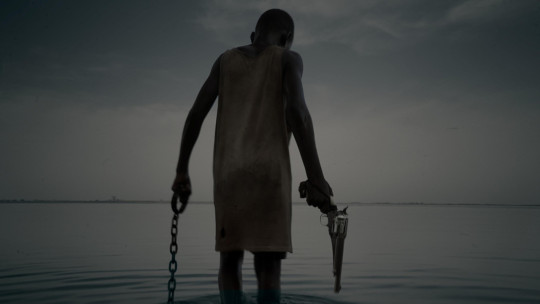
‘Saloum’, directed by Jean Luc Herbulot.
Peter, what’s a movie from this year’s Midnight Madness lineup you’d love to recommend?
Peter Kuplowsky: We’ve got a lot of firsts at Midnight this year. We have Saloum, the first time a West African film has ever been in Midnight. We’ve also got Zalava, which is the first Iranian film to play in Midnight. Our opening film for Midnight Madness is Julia Ducournau’s Titane, which is playing at the Princess of Wales theater, and will be a spectacle to behold. When I’m looking for Midnight Madness, I like hearing the audience make certain noises in the room, whether that’s a gasp or screams or laughter. I feel that every note on the scale is going to be played during Titane by the audience.
Brilliant. Now, we’re going to bring in some audience questions. First up is Vincent, who says that one of their favorite films is Georges Franju’s Eyes Without a Face, and asks if there are any films in this year’s TIFF lineup you could recommend for a fan of that film?
PK: I’ve really been encouraging people to check out the films I just mentioned, Zalava and Saloum, and I think Zalava especially would fit here, as it’s more of a horror-drama. It begins as something that is steeped in the supernatural, but as it escalates it becomes something of a pitch-black comedy while still maintaining a gravitas to it. I think it’s one of the most fascinating discoveries in the genre space this year.
CB: I’d also add Good Madam, by Jenna Bass, from South Africa. It is a chilling movie, with a bit of an Eyes Without a Face vibe. If you like that sort of approach to cinema, I think you’ll like that.
PK: Vengeance Is Mine, All Others Pay Cash just won the Golden Leopard at Locarno. With a title like that, this is a film that feels like it’s going to be sort of a strictly pulp crime film, but it’s so much more. It’s deeply romantic, incredibly eclectic, and beautifully shot on 16mm film. It feels like a film that was hidden away, shot in the late ’70s or early ’80s. It’s a throwback to 1980s Hong Kong action films, while also, I can’t stress this enough, being one of the most romantic films in the festival. You’ll fall in love with this relationship while it’s also working in fight sequences and magical realism.
Nataleah, what’s something you would recommend from your TIFF selections from Africa, “the Middle East” and the Black Diaspora?
Nataleah Hunter-Young: One I’d highly recommend is Costa Brava, directed by Mounia Akl, from Lebanon. Even amidst what’s going on in Lebanon right now, the film offers a beautiful and engrossing portrait of a family that includes a grandmother who’s a non-actor, but has impeccable comedic timing (that travels through the subtitles if you don’t speak Arabic).

‘Snakehead’, written and directed by Evan Leong.
Robyn, what’s a movie that surprised you most during your selections this year?
Robyn Citizen: I always recommend that people check out our Discovery section because that’s where we find new talent and nurture new voices. The film that really surprised me this year was Snakehead, by Evan Jackson Leong. Some people will know him from a documentary called Linsanity, and he did another documentary about evangelism in Korea. Snakehead has been a ten-year labor of love for him. He had to do a Kickstarter for the film, which is loosely based on the life of a woman named Sister Ping, who had a human trafficking ring that was the biggest trafficking ring for about 20 years.
The film tackles what’s going on now with vulnerable populations being trafficked into America, in particular Chinatown in the US, and the main character, played by Shuya Chang, has to fight to find her daughter. It’s an exciting film, and very moving. It’s extremely tightly edited, and it looks fantastic.
We’ve got our next question here from a member who says their favorite genre is science-fiction. While Dune is at the top of their watchlist, are there any other sci-fi selections you could recommend?
PK: I would recommend After Blue (Dirty Paradise), which is a perverse science-fiction by Bertrand Mandico. It reminds me a lot of the French animated film Fantastic Planet. This one is about a planet which is inhospitable to men because of the way hair grows. The plot follows a young teenage girl who accidentally unleashes a notorious criminal that she and her hairdresser mother have to stalk through the alien landscape that is full of bizarre creatures and liquids and gases. I feel it’s kind of like the inverse of Dune, and an opportunity to explore a bizarre ecosystem.
NHY: I would totally insist that this member see Neptune Frost, from Saul Williams and Anisia Uzeyman. It’s a difficult film to put into words, but I’ve been summing it up by calling it an Afro-sonic sci-fi musical.
Whoa, that sounds like a whole new subgenre.
NHY: That’s just the beginning. There’s a lot to experience in this film. It’s a cosmic romance that follows an intersex hacker and a coltan miner who make their way to this kind of dream space where they connect with others as they travel through these lush mountainous regions of Rwanda and Burundi. It’s a beautiful anti-narrative that is impeccably colored and totally consuming. It’s a must-see for anybody who loves cinema.
Diana, what would you say is the best debut feature that you’ve seen among this year’s international selections?
Diana Cadavid: There are so many wonderful new talents, but I think I’ll go with an Argentinian filmmaker named Agustina San Martín. Her film, To Kill the Beast, is a co-production between Argentina, Brazil and Chile, and she worked for nine years to put this all together. She started working on it when she was 21, and we were actually having a conversation yesterday about her process, and how it’s a film that deals with the growth of a woman, and female desire. There’s this idea of the beast, something that’s either from inside or from outside forces, trying to control the human mind and body. It’s a very interesting film, gorgeously shot and very atmospheric.
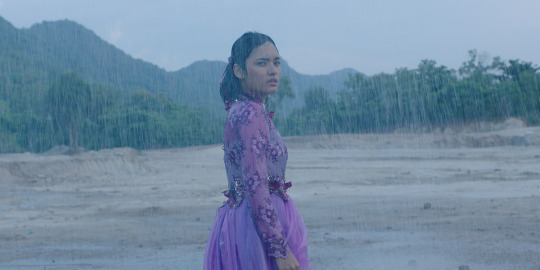
‘Yuni’, written by Prima Rusdi and Kamila Andini, directed by Andini.
We’ve got another question here from David, who says their favorite films are humanistic dramas, citing Hirokazu Kore-eda as one of their favorite directors. Would anybody have any recommendations for David?
CB: I can recommend at least one film, called Yuni, an Indonesian film from Kamila Andini. This is a naturalist drama about a high-school girl who is one of the top students in her class, and has a great group of friends. We slowly begin to see that her life is being constrained by one man after another, and then something happens at school, which begins to narrow her possibilities for her future. She’s trying to figure out things like sexuality and romance and what she wants to do with her future, and all of these obstacles keep getting placed in her path. It’s told in a very gentle way, but very incisive as well. Each scene really matters, taking you deeper inside this girl’s life.
RC: Our senior programmer Giovanna Fulvi programmed a film called Aloners, a South Korean film by Hong Sung-eun. This is her first feature, and it’s very much a film of our time. It is about a woman who works in the gig economy at a credit-card customer-service call center. It’s a very transient existence. She doesn’t talk to anybody, she eats by herself, she doesn’t really want to associate with the people in her apartment building. One day, one of her neighbors who has tried to talk to her many times passes away, and she has to re-interrogate the way that she’s been living her life, and figure out if it’s worth starting to form some human connections.
Next up is a question from Matt Neglia, from the Next Best Picture podcast. Matt says that he’s a massive fan of epics, whether they’re three hours long or just telling an expansive story with lots of world-building. Apart from Dune, are there any other films in the lineup that you would describe as epic?
CB: While Joachim Trier’s The Worst Person in the World might not strike you on reading its synopsis as an epic, I think it actually is an emotional epic. It’s the story of a young woman who’s trying to figure out her life. Her romance with one boyfriend doesn’t quite fit the bill for her, and she begins this looking and exploring. Trier and his writer and lead actor do remarkable work, blowing open the idea of a person trying to define who they are at this turning point in their life. They make these stakes massive and they have all kinds of interesting, innovative, formal elements in [the film] as well. It’s incredibly cinematic. If you’ve seen Joachim Trier’s other films, this is kind of the conclusion of a trilogy that he’s made.

‘Listening to Kenny G’, directed by Penny Lane.
Next up, we have Sarah, who is looking for movies about music, and also some body horror.
CB: We’ve got a number of great music docs this year. I have to mention Dionne Warwick, the queen of Twitter, who is the subject of Dionne Warwick: Don’t Make Me Over. It tells the story of this incredibly talented, determined and glamorous musician who broke so many barriers. She toured in the south during the Jim Crow era, making gains as a Black woman in the music industry and in the pop-music industry, not the so-called race-record or Black-music industry, which simply wasn’t done at the time. This documentary tells that story, and also shows her later work in the ’80s contributing to the fight against stigma and hysteria during the AIDS crisis.
PK: I’ll follow up Cameron by mentioning the Alanis Morissette film Jagged. We’ve also got a film about the great jazz pianist, Oscar Peterson, called Oscar Peterson: Black + White. Lastly, there’s a film about Kenny G, called Listening to Kenny G.
Diana Sanchez: For the body horror, I’d like to mention the debut film by Ruth Paxton, titled A Banquet. It’s about a young woman who insists her body is no longer her own, and is a service to a higher power. Her mother has no idea what to think. She stops eating, and her mother doesn’t know [whether] to believe her or not. I love Ruth Paxton’s work, the way she shoots the film, the way she shoots the food. It’s almost, as she refers to it, pornographic. It looks delicious and gross all at the same time.
I’d also like to flip to comedy quickly to mention Official Competition. The film stars Penélope Cruz, Antonio Banderas and Oscar Martínez. Cruz plays a filmmaker who puts together a well-known theater actor and a well-known box-office glamor guy, played by Banderas. The film speaks to the tension between high art and more popular art, testing those boundaries. It’s incredibly funny.
We’d love to squeeze a few more films out of everyone for our watchlists. Could you each recommend one film and try to sell it in ten words or less?
CB: Let me try. Sundown, by Michel Franco. Tim Roth falls apart beautifully in Mexico.
TP: I’m going to go with the Mexican documentary, Comala. Filmmaker Gian Cassini explores the legacy of his father, who was a Tijuana hitman.
PK: I’ll go with Saloum, which is basically From Dusk Till Dawn in West Africa.
RC: I’m going to say The Wheel, a movie by Steve Pink. If you like Who’s Afraid of Virginia Woolf?, this is like that with a younger couple in a much more humane, intimate key.
DS: I’ll say I’m Your Man, a sci-fi where Maren Eggert dates a robotic Dan Stevens.
PK: I know Diana has been recommending a film called OUT OF SYNC, about an artist who begins to experience the sound of the world going out of sync. She starts hearing sounds from the past because people and things are out of sync with their surroundings.
NHY: I’ll go with The Gravedigger’s Wife, directed by Khadar Ahmed. It showcases the horn of Africa unlike you’ve ever seen it on screen.
Finally, for Cameron: with fall coming, what is the best TIFF 2021 movie to watch under a blanket, either because it’s cozy or because you’re terrified, or both?
CB: Great question, which gives me a chance to talk about Earwig, the new film by Lucile Hadžihalilović. If you’ve seen Innocence or Evolution, her two most recent films, you’re prepared in terms of tone, but you’ve not even seen Lucille make a film quite like this. It’s eerie, disturbing, hypnotic, mesmerizing. You can’t stop watching, but you’re always afraid that something awful and horrifying is about to happen… and maybe it might.
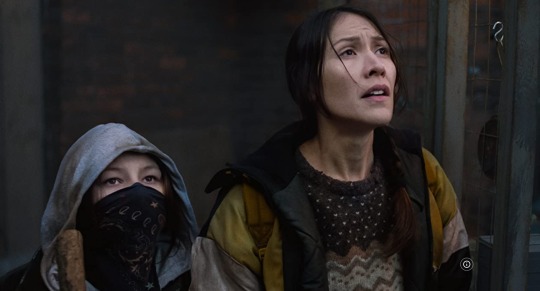
‘Night Raiders’, written and directed by Danis Goulet.
To bring it all back home, what would you say is the Canadian film of 2021?
CB: It’s always hard to say, but I think in a year where we have Danis Goulet’s feature Night Raiders, that’s got to be the one. Danis has made some exceptional short films over the last few years that people might know. Her feature takes on the horrific, devastating story of residential schools and children torn from Indigenous families and put in institutions where the goal was to erase their Indigenous identity. She takes that terrible, real history that we’re grappling with right now in Canada, and turns it into a piece of speculative fiction, a kind of propulsive thriller.
By turning it into fiction rather than reality she can use all of the tools of cinema to tell a terrific story that’s exciting and has high stakes, but also has this deep resonance of a truth that we are, I hope, coming to terms with in this country.
The Toronto International Film Festival runs from September 9 to 18. This conversation has been edited for length and clarity. Follow TIFF on Letterboxd, and follow our Festiville HQ for regular festival updates.
#tiff#tiff21#tiff 21#tiff 2021#toronto#toronto international film festival#cameron bailey#midnight madness#jessica chastain#jane campion#benedict cumberbatch#saul williams#danis goulet#canadian film#letterboxd#festiville#letterboxd festiville#gemma gracewood#thom powers#nataleah hunter-young
3 notes
·
View notes